Abstract
Organic/polymer light-emitting diodes (OLEDs/PLEDs) have attracted a rising number of investigations due to their promising applications for high-resolution fullcolor displays and energy-saving solid-state lightings. Near-infrared (NIR) emitting dyes have gained increasing attention for their potential applications in electroluminescence and optical imaging in optical tele-communication platforms, sensing and medical diagnosis in recent decades. And a growing number of people focus on the “heavy metal-free” NIR electroluminescent materials to gain more design freedom with cost advantage. This review presents recent progresses in conjugated polymers and organic molecules for OLEDs/PLEDs according to their different luminous mechanism and constructing systems. The relationships between the organic fluorophores structures and electroluminescence properties are the main focus of this review. Finally, the approaches to enhance the performance of NIR OLEDs/PLEDs are described briefly. We hope that this review could provide a new perspective for NIR materials and inspire breakthroughs in fundamental research and applications.
1. Introduction
In 1987, the thin-film organic light-emitting diodes (OLEDs) which have high brightness and high electroluminescent efficiency at low driving voltage was launched by Tang and Vanslyke [1]. Since then, the applications of organic/polymer light emitting diodes (OLEDs/PLEDs) in solid-state lighting source and flat-panel displays have entered a new period [2,3,4]. After years of hard works, OLEDs/PLEDs have been used to achieve great breakthroughs, especially in the visible region (400–700 nm) [5,6,7,8]. Up to now, Near-infrared (NIR)-emitting organic materials have aroused growing interest on account of promising applications in some fields such as infrared signaling and displays, bio-sensing, and telecommunications. A rising number of investigations have been made to develop NIR luminescent materials with an emission wavelength longer than 700 nm due to its potential applications in bio-imaging [9,10,11,12], chemical sensors [13,14,15,16], light emitting electrochemical cells (LECs) [17,18,19,20], OLEDs [21,22,23,24] and photovoltaic cells [25,26,27,28] etc.
To date, the materials with NIR-emitting are mainly grouped into two categories: inorganic luminescent materials including rare earth metals [29,30,31] and alkaline earth metal luminescent materials [32], and organic luminescent materials covering transition metal complexes [33,34,35,36], small molecules [37,38,39] and polymers [40,41,42]. According to the mechanism of luminescence, these emitters are divided into two types, fluorescent [43] and phosphorescent materials [44,45,46]. The luminescence is generally defined as the radiation emitted by the atoms or molecule return to the lower energy state after the material absorbing energy and jumping to the excited state of the higher energy level. The main types of luminescence include fluorescence and phosphorescence. As shown in Figure 1, the emission originated from the transition that from the lowest excited singlet state (S1) to the lowest excited singlet state to the singlet ground state (S0) is called fluorescence, while the emission from the lowest excited triplet state (T1) to S0 is called phosphorescence.
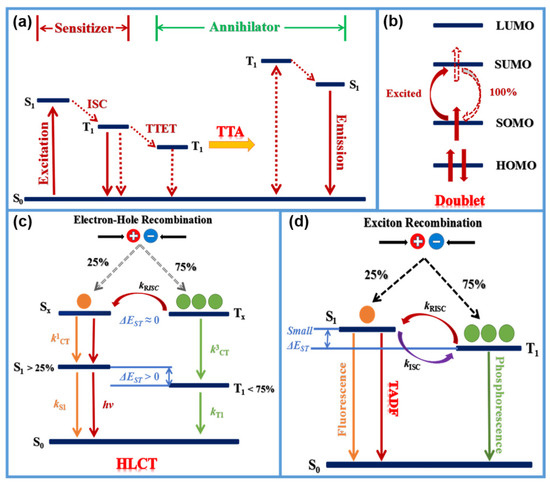
Figure 1.
Brief mechanisms for (a) TTA, (b) doublet, (c) HLCT, (d) fluorescence, phosphorescence, and TADF.
Considering that the price and rarity of the heavy metals elevate the cost and limit of their mass processing and limit the future application, a growing number of people focus on the pure organic NIR electroluminescent materials to gain more design freedom with a cost advantage. The mechanical adaptability of organic NIR light-emitting materials also makes them have broad application prospects in flexible and stretchable devices. In addition, metal-free organic light-emitting materials could be used as biocompatible substitutes for inorganic materials, and could be used in implantable, wearable or medical applications in vivo. As shown in Figure 1, in addition to traditional fluorescent materials that just could utilize the singlet excitons, there are several new types of materials that can greatly improve quantum efficiency by taking advantage of singlet and triplet excitons at the same time. (1) The materials with triplet-triplet annihilation (TTA) [47,48] can provide 62.5% energy utilization through two triplet excitons annihilating to form a higher energy triplet exciton. (2) For doublet [49,50], only one electron occupies the highest singly occupied molecular orbital (SOMO). When this electron is excited to the lowest singly unoccupied molecular orbital (SUMO), the SOMO is empty, and transition of the excited electron back to the SOMO is totally spin-allowed. (3) The hybridized local and charge-transfer state (HLCT) material [51,52,53] with the “hot excitons” which could undergo a reverse intersystem crossing process (RISC) through the high-lying channel, and then the excitons could go through a radiative transition to the low-lying locally excited (LE) state to produce a radiative exciton ratio that break through the limit of 25% of spin statistics. (4) The thermally activated delayed fluorescence (TADF) [54,55,56] materials with small singlet-triplet energy gap (ΔEST) make use of efficient reverse intersystem crossing (RISC) from the lowest triplet state (T1) to the lowest singlet state (S1) so that the theoretical internal quantum efficiency can reach 100%.
Until now, plenty of materials with high-efficiency NIR-OLEDs/PLEDs have been researched. Primitively, researchers usually utilized the rare earth metal complexes as emitters for the NIR OLEDs, such as erbium (Er) [57,58], neodymium (Nd) [59] and lanthanum (La) [60]. Nevertheless, the luminescence efficiency of these OLEDs is quite low and inefficient for practical application. Afterwards, the focus of study has turned to organic polymers, small molecules and transition metal complexes for high-efficiency NIR-OLEDs/PLEDs gradually.
This article summarizes recent progresses on pure organic compounds and their applications in OLEDs/PLEDs. The design and development of “heavy metal-free” NIR electroluminescent materials for high-efficiency OLEDs, as well as their challenges, are also discussed.
2. Tuning the Emission of Materials into NIR Region
The energy gap of the organic molecules is the decisive factor in the optical and electronic properties, which means the energy separation between the highest occupied molecular orbital (HOMO) and lowest unoccupied molecular orbital (LUMO), also called the HOMO-LUMO gap (HLG) [61]. There are several approaches to construct molecules with NIR emission. Diminution of the HLG is the key to result the absorption and emission spectra. Generally speaking, when tuning the HLG of molecules, several factors should be considered, including conjugation length, bond length alternation, and donor-acceptor (D-A) charge transfer [62,63,64]. For the π-conjugated systems, extension of its conjugation length can lead to a decrease in the HLG for certain. As shown in Figure 2, Mullen et al. [65] tuned the energy gap over a quite large range from probably 1.29 eV (960 nm) to 2.15 eV (577 nm) by adjusting the number of naphthalene units of the rylenediimide dyes. And the energy gap has a gradual downtrend as the size of polycyclic aromatic hydrocarbons grow, starting from benzene to the one containing 222 carbons by the number of benzene units or sextet carbons (Figure 3) [66]. In the polycyclic aromatic hydrocarbons systems, the energy gap is generated by alternating single and double bonds. The smaller bond length alternation is, the lower energy gap of a conjugated compound will be. As a result, reducing the bond length alternation is a significant step toward the reduction of the energy gap in the conjugated systems. In addition to these, introduction of an intramolecular D-A system in organic polymers is a popular strategy of lowering the energy gap [67]. The hybridization of energy level after donor and acceptor bonding could make the energy level of HOMO higher than that of donor, while the energy level of LUMO is lower than that of acceptor, resulting in abnormally small HOMO-LUMO separation. (Figure 4a) [68,69]. For example, Skene et al. [70] synthesized azomethines compound with the maximal absorption and emission are 440 and 534 nm. In addition, on this basis, they got the push-push (D-D), pull-pull (A-A) and push-pull (D-A) azomethines by substituting the donor and acceptor groups at both ends. The D-A azomethines has the most obvious red-shifts in absorption (148 nm) and emission (126 nm), as shown in Figure 4b.
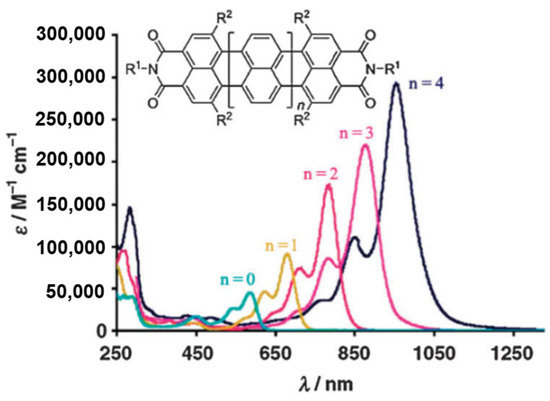
Figure 2.
Absorption spectra of the entire tetraphenoxy-substituted rylenediimide series in CHCl3 (adapted from ref. [65]).
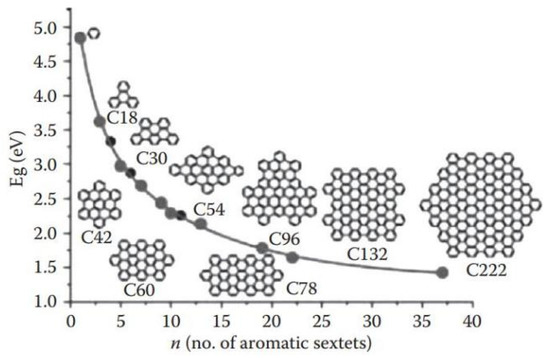
Figure 3.
Correlation of the energy gap versus the number of aromatic sextets. (adapted from ref. [66]).

Figure 4.
(a) Interaction of energy levels of a donor (D) and acceptor (A) leading to a narrower HLG; (b) Chemical structures of push-push (D-D), pull-pull (A-A) and push-pull (D-A) azomethines.
As previously mentioned, the effects on tuning the energy gap are mainly related to the individual molecules without consideration of intermolecular interaction. The intermolecular interaction, for instance, the molecular π-π stacking, hydrogen bonding and charge transfer could also have the influence on altering the band gap of the molecules in the solid states [71,72,73,74,75]. According to the above approaches, researchers have designed and organized NIR luminescent materials.
3. NIR Fluorescent Materials Based on Polymers
Conjugated polymers with fluorescence units have attracted a multitude of attention due to the academic and commercial value when used as the active materials in PLEDs [76]. The turn-on voltage, color purity, and stability of the devices should be optimized to accommodate PLEDs. Some of the principal advantages of conjugated polymers are easy manufacture, solution processability, low-cost, flexibility and suitability to form large area surfaces [77]. The synthetic organic flexibility is the most obvious feature of the conjugated polymers. Through the manipulation of the structures of the monomer and polymer, the physical, thermal, optical, and electrochemical properties could be adjusted for specific applications.
For conjugated polymer, the value of the energy level band gap is the key to their performance in PLEDs. The most common and effective approach is introducing D-A units consisting of various donors and acceptors to tune the HOMO-LUMO levels. In 2004, Thompson et al. [78] synthesized 2-((E)-2,5-bis(hexadecyloxy)-4-methylstyryl)-5-((E)-prop-1-en-1-yl)pyridine (P1) and 5-((E)-2,5-bis(hexadecyloxy)-4-methylstyryl)-2,3-diphenyl-8-((E)-prop-1-en-1-yl)pyrido[3,4-b]pyrazine (P2), as shown in Figure 5. The band gap of polymer lower from 2.2 to 1.8 eV when the pyridine acceptor has been replaced by the much stronger electron-accepting pyridopyrazine. And P2 has been used in PLEDs, which show a broad emission centered in the NIR at 800 nm. The results illustrate that the incorporation of the more strongly electron-accepting unit could decrease the band gap and obtain a considerable red-shift in the photoluminescence and electroluminescence. In 2005, Gadisa et al. [79] used the same way to make the polymer bathochromic-shift. Poly(2,7-(9,9-dioctyl-fluorene)-alt-5,5-(4′,9′-di-2-thienyl-6′,7′-diphenyl-[1′,2′,5′]thiadiazolo-[3′,4′]-g]quinoxaline)) (P4) showed a significant red-shift of 245 nm in comparison with poly(2,7-(9,9-dioctyl-fluorene)-alt-5,5-(4′,7′-di-2-thienyl-2′,1′,3′-benzothiadiazole)) (P3) (Figure 5). In 2011, Cacialli et al. [41] reported the low-gap polymer poly[5,7-bis(5-thiophen-2-yl)-2,3-diphenyl-thieno[3,4-b]pyrazine-alt-2,6(4,4-bis(2-ethylhexyl))-4H-cyclopenta[2,1-b;3,4-b′]dithiophene] (P5) containing cyclopentadithiophene (CPDT) repeat units that several polymers containing it with good performance in photovoltaic applications (Figure 5) [80,81]. The band gap is only about 1.3 eV. It showed clear NIR emission at 956 nm for the unblended device with a low external quantum efficiency (EQE) of 0.003%. In the blended devices, an 80 nm blue-shift in the emission and an increase in the EQE of 0.02% can be observed. And Reynolds et al. [82] demonstrated the ability of the alternating polyfluorene (APFO) type polymer poly[9,9-dioctyl-2,7-9H-fluorene-alt-4,7-Bis-(5-bromo-3,4-dipropoxy-thiophen-2-yl)-benzo [1,2,5]thiadiazole (P6) employing dialkoxythiophene and benzothiadiazole (BT) units to construct donor-acceptor-donor (D-A-D) system to operate efficiently as the electroluminescent (EL) material (Figure 5). The BT moiety is frequently used in the design of the D-A type of π-conjugated organic compounds due to the low position of its LUMO energy level and good stability of BT derivatives in the reduced state [83,84,85]. The PLEDs show strong NIR electroluminescence with an emission maximum at 742 nm and a notable EQE of 0.3%. In 2013, Cacialli et al. [86] presented NIR-PLEDs based on a fluorene-dioctyloxy-phenylene wide-gap host material copolymerized with a low-gap emitter P7 (Figure 5). The 1 mol% loading yielded optimum device performance with an EQE of 0.04% emitting at 909 nm. The high spectral purity of the PLEDs combined with their performance support the methodology of copolymerization as an effective strategy for developing NIR-PLEDs. In the next year they investigated phthalimide based polymers as new host materials due to their ambipolar and luminescent properties [87]. Using the host phthalimide-thiophene copolymer P8 (Figure 5) combined with the bisthienyl(benzotriazolothiadiazole) emitter (D-A-D) resulted in the much more efficient single layer NIR-PLED to date with an EQE of 0.27% emitting at 885 nm. Then they [88] reported a new NIR emitting copolymer P9 (Figure 5) based on 6-(2-butyloctyl)-4,8-di(thiophen-2-yl)-[1,2,3]triazolo[4′,5′:4,5]benzo[1,2-c][1,2,5]thiadiazole (TBTTT) as the NIR emitter and poly[3,3′-ditetradecyl-2,2′-bithiophene-5,5′-diyl-alt-5-(2-ethylhexyl)-4H-thieno[3,4-c]pyrrole-4,6(5H)-dione-1,3-diyl] (P2TTPD) as the host. Pure NIR emission up to 930 nm is obtained by incorporating the D-A-D segment into the P2TTPD backbone.
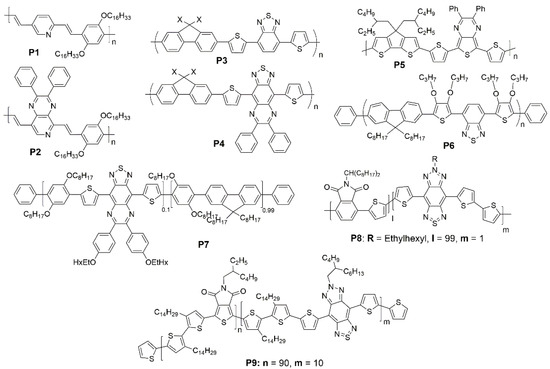
Figure 5.
Chemical structures of P1 to P9.
Another approach to lower the band gap is utilizing the polar effect caused by the heavy atoms. The notable cases of decreasing the energy gap involve the replacement of oxygen and sulfur atoms with heavier ones like selenium and tellurium in a conjugated system [71]. The band gap drop off 0.1 eV and a redshift of 90 nm in electroluminescence maximum was observed in a fluorene-based copolymers poly[2,7-(9,9-dioctylfluorene)-co-5′,5″-(4,7-diselenophen-2′-yl)-2,1,3-benzothiadiazole] (P10) and poly[2,7-(9,9-dioctylfluorene)-co-5′,5″-(4,7-diselenophen-2′-yl)-2,1,3-benzoselenadiazole] (P11) when the sulfur is replaced with the selenium (Figure 6) [40]. In 2015, Cacialli et al. [89] also showed the substitution of a sulphur atom (P12) with a selenium (P13) atom to further extend the emission in the NIR up to 1000 nm (Figure 6). PLEDs based on copolymers P12 give the notable EQE (0.09%) and show an almost pure NIR EL (95% in the NIR) peaking at 895 nm.
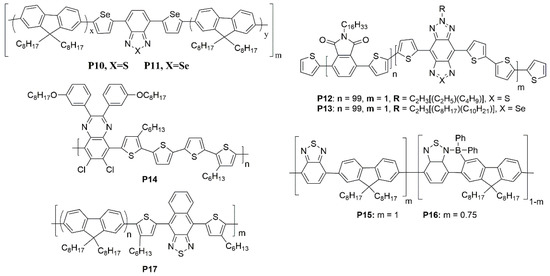
Figure 6.
Chemical structures of P10 to P17.
Moreover, there are several methods to get NIR PLED using polymers as emitters. Tu et al. [90] presented the efficient D-A alternating conjugated polymer 6,7-dichloro-5-(3,3‴-dihexyl-5‴-methyl-[2,2′:5′,2″:5″,2‴-quaterthiophen]-5-yl)-8-methyl-2,3-bis(3-(octyloxy)phenyl)quinoxaline (P14) bearing chlorine atoms on the backbone for NIR PLEDs (Figure 6). Based on the following three points, chlorine-containing D-A alternated copolymers are expected to show special merits in PLED: (a) The covalent radius of chlorine atom is as large as 102 pm, so this steric hindrance is large enough to synthesize atropisomers [91,92]. The notable steric hindrance will not only inhibit aggregation induced emission quenching but also block nonradiative processes due to some rotational motions in the solid state; (b) chlorine-bearing D-A alternating copolymers exhibited large Stokes shift and low self-absorption; (c) the frontier orbital levels of the chlorine-bearing D-A alternating copolymers can be finely tuned by using different donor or acceptor moieties. NIR emission centered at 708 nm was obtained with brightness over 400 cd/m2 based on dopant/host system. Ingleson et al. [42] reported the C-H electrophilic borylation is a simple and general high yielding approach to introduce controlled concentrations of low band gap chromophores into conjugated polymer poly((9,9-dioctylfluorene)-2,7-diyl-alt-[4,7-bis(3-hexylthien-5-yl)-2,1,3-benzothiadiazole]-2c,2cc-diyl) (P16) main chains and red shift the emission by >150 nm relative to the pristine polymer poly(9,9-dioctylfluorene-alt-benzothiadiazole) (P15) (Figure 6). Cao et al. [93] obtained an efficient bilayer NIR-PLED with maximum EQE up to 2.1% (λmax = 758 nm), in which where layer 1 was phenyl-substituted poly [p-phenylphenylenevinylene] derivative (P-PPV), layer 2 was 9,9-dioctylfluorene (DOF) and 4,7-bis(3-hexylthiophen)-2-yl-2,1,3-naphthothiadiazole (HDNT) copolymer 4-(4-hexyl-5-(7-methyl-9,9-dioctyl-9H-fluoren-2-yl)thiophen-2-yl)-9-(4-hexyl-5-methylthiophen-2-yl)naphtho[2,3-c][1,2,5]thiadiazole (P17) (Figure 6). The improvement of the diode’s performances was considered to be the irradiative excitons confined in the interface between the two layers. In 2022, Lu et al. [94] found that the thieno[3,4-b]pyrazines (TP) could be employed as acceptor and donor units simultaneously to produce a low band-gap polymer, so they utilized this unit to build three TP-based alternating π-conjugated polymers, poly[(9,9-dioctylfluorene-2,7-diyl)-(2,3-dimethylthieno[3,4-b]-pyrazine)] (P18), poly[(9-(1-octylnonyl)-9H-carbazole-2,7-diyl)-(2,3-dimethylthieno[3,4-b]pyrazine)] (P19), and poly[5,5-dioctyl-5H-dibenzo[b,d]silole-3,7-diyl)-(2,3-dimet-hylthieno[3,4-b]pyrazine)] (P20) (Figure 7) with the intramolecular charge transfer (ICT) characteristics. All polymers showed strong deep red/NIR emission and the emission maxima of EL devices based on the P18, P19 and P20 are 772, 764 and 775 nm, respectively, and the EQEmax is for P20-based PLED devices, are almost four times larger than that for P19-based devices. It demonstrated that silole-containing materials had excellent electronic transmission performance originating from σ*-π* conjugation. Thus, the higher device efficiency of P20 should be related to a better balance of hole and electron currents.
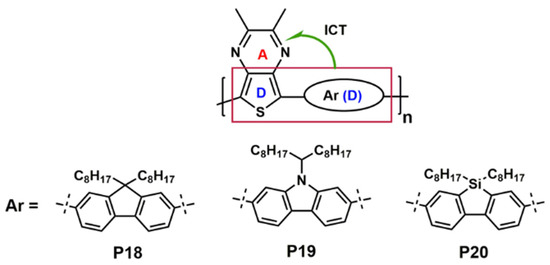
Figure 7.
ICT interaction of P18 to P20.
In Table 1, the photophysical and electroluminescent properties of polymers from P1 to P20 are summarized. Although a substantial part of the PLEDs research is focused on conjugated polymer materials, their efficiencies are still far behind that of organic phosphorescent materials.

Table 1.
Photophysical and electroluminescent properties of some NIR conjugated polymers.
4. NIR Fluorescent Materials Based on Small Molecules
Due to the parity-forbidden radiative 4f-4f transitions of the rare earth ions, the corresponding LEDs usually have a nonmeasurable or very low EQE and low power output. In contrast, the luminescence of organic molecules originates from their allowed S1–S0 transitions and thus free from the luminescence efficiency limitation. By using phosphorescent heavy metal complexes that can effectively harvest both the singlet and triplet excitons. Unfortunately, the EL quantum efficiency drops rapidly at high current densities. Therefore, in order to develop NIR-OLEDs/PLEDs with a high EQE, the research on efficient and stable fluorescent NIR-emitting materials is continuing.
Initially, attempts were made to construct NIR luminescent materials using molecules with a large area of conjugated systems. In 2006, Kageyama et al. [95] investigated that OLED (Figure 8) using tris(8-quinolinolato)aluminum (Alq3) highly doped with N,N′ -bis(neopentyl)-3,4:9,10-perylenebis(dicarboximide) (M1) as an emitting layer exhibit near-infrared EL with a peak at 805 nm originating from M1 aggregates (Figure 9). Phthalocyanines are known to be organic semiconductors and have attracted much attention because of their high chemical stability, various synthetic modifications, epitaxial growth of thin films by organic molecular beam epitaxy and unique absorption bands extending from the ultraviolet region to infrared region [96,97]. Cheng et al. [98] reported the OLED device used purple phthalocyanine (M2) single crystal as an active light-emitting layer with the emission of 936 nm (Figure 9). And Du et al. fabricated NIR OLEDs based on Tetra (2-Isopropyl-5-methylphenoxyl) substituted phthalocyanine (M3) [99] and tetra-(methoxyphenoxy) substituted phthalocyanine (M4) (Figure 9) [100]. The EL intensity at about 910 nm in the devices based on M3 was increased by about 14 times compared with the intensity at about 930 nm in the devices based on M2 in the same device structures. The improvement in the EL intensity was attributed to the large steric hindrance of non-peripheral phenoxyl substituent of M3. The emission of the NIR-OLEDs based on M4 was observed near 891 nm. Sharbati et al. [101] demonstrated an efficient NIR electroluminescence from OLED based on imine oligomer (E)-N-((E)-3-((E)-(4-iodophenyl-imino)methyl)benzyldine)-4-iodobenzenamine (M5) (Figure 9). Electroluminescence with peak emission wavelengths of 800 nm and maximum EQE of 1.9% were observed. Mateo-Alonso et al. [102] presented an extended and distorted member 7,8,15,16,23,24-hexaazatrianthrylene (M6) of the N-containing starphene family due to their excellent electron-transporting ability (Figure 9). The electroluminescence of the OLEDs based on M6 appeared at substantially higher wavelengths (centred at 848 nm) than the previously reported heterojunctions with hexaazatrinaphtylene (HATANT) derivatives [103,104], which illustrated that electron-deficient N-containing starphenes could be considered a general platform to prepare and fine-tune the properties of NIR-OLEDs.
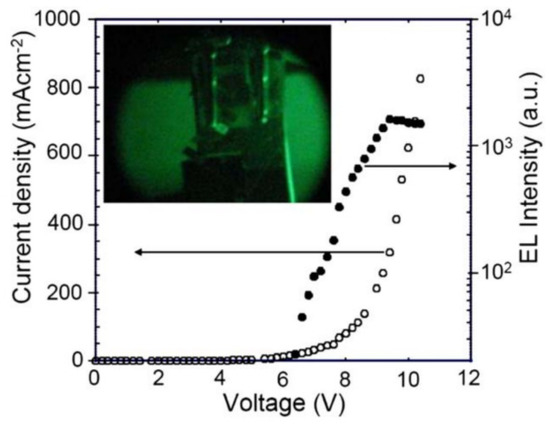
Figure 8.
Current density–voltage-luminance characteristics of the M1-based OLED device. The upper inset shows a photo of near-infrared EL obtained for the device at a drive voltage of 9.4 V, taken with an infrared scope (adapted from ref. [95]).
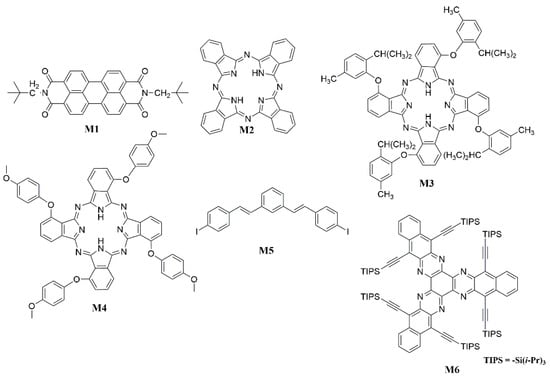
Figure 9.
Chemical structures of M1 to M6.
Among many low band gap organic compounds, the D-A type of chromophores are particularly of interest to researchers as potential NIR chromophores because their band gap levels and other properties can be readily tuned through a variety of donors and acceptors [105]. In 2008, Wang et al. [106] synthesized the NIR fluorescent compounds M7 and M8 with a combination of triphenylamine (TPA), thiophene, and benzo[1,2-c:4,5-c′]bis([1,2,5]thiadiazole) (BBTD) in the D-A-D system that could lead to the longest emission wavelength and the narrowest band gap (Figure 10). The TPA unit was used as donor with prominent hole-transporting ability and the BBTD-type unit was used as acceptor, which is known to possess substantial quinoidal characters within a conjugated backbone, allowing for greater electron delocalization and thus lowering of the band gap. The OLED device (M7) with exclusive NIR emission at 1050 nm and an EQE of 0.05% has been realized. By doping M8, the emission wavelength can be extended up to 1115 nm. One year later, Wang et al. used the same acceptor and different TPA-type donors to synthesize a series of simple NIR organic materials, 4,8-Bis[4-(N,N-diphenylamino)phenyl]benzo[1,2-c:4,5-c()bis[1,2,5]thiadiazole (M9); 4,8-Bis[4-(N-phenyl-N-(4-methylphenyl)amino)phenyl]benzo[1,2-c:4,5-c()bis[1,2,5]thiadiazole (M10); 4,8-Bis[4-(N-phenyl-N-(1-naphthyl)amino)phenyl]benzo[1,2-c:4,5-c()bis[1,2,5]thiadiazole (M11) and 4,8-Bis[5-(N,N-diphenylamino)-2-thiophene]benzo[1,2-c:4,5-c()bis[1,2,5]thiadiazole (M12) (Figure 10) [107]. The non-planar TPA unit is available to improve carrier-transporting properties and suppress aggregations. The emission-peak maxima of NIR-OLEDs based on these compounds are all above 1000 nm, and the longest EL is at 1220 nm for M12. Nondoped OLED (M10) achieved NIR emission exclusively at 1080 nm with EQE of 0.73%. Then Wang et al. [108] want to utilize the guest-host system with several requirements be considered and met. At first, the host materials should have high film-forming ability and carrier-transport ability. Secondly, the guest materials should have high emission efficiency. Thirdly, the emission of the host should overlap well with the absorption of guest, which is in favor of the energy transfer. Alq3 was choosed as the host due to its widespread application as a host for organic NIR fluorescent chromophores. A series of a D-A-D type of NIR fluorescent chromophores (4,9-Bis[4-(N,N-diphenylamino)phenyl][1,2,5]thiadiazolo-[3,4-g]quinoxaline (M13), 4,9-Bis[4-(N,N-diphenylamino)phenyl]-6,7-diphenyl[1,2,5]thiadiazolo[3,4-g]quinoxaline (M14) and 4,15-Bis[4-(N,N-diphenylamino)phenyl][1,2,5]thiadiazolo-[3,4-i]dibenzo[a,c]phenazine (M15)) were designed as the guest (Figure 10), which based on [1,2,5]thiadiazolo[3,4-g]quinoxaline (TQ) as an acceptor and TPA as a donor due to the D-A charge transfer absorption bands should be more suitable for the EL band of Alq3. The doped OLEDs emit NIR light from 748 to 870 nm with high efficiency and radiance. Particularly, the device containing M13 as a dopant exhibits an exclusive NIR EL at 752 nm with an EQE of 1.12% and the largest radiance of 2880 mW Sr−1 m−2. And Xue et al. [109] reported NIR-OLEDs based on two D-A-D conjugated oligomers, 4,8-bis(2,3-dihydrothieno-[3,4-b][1,4]dioxin-5-yl-benzo[1,2-c;4,5-c′]bis[1,2,5]thiadiazole (M16) and 4,9-bis(2,3-dihydrothieno[3,4-b][1,4]dioxin-5-yl)-6,7-dimethyl-[1,2,5]thiadiazolo[3,4-g]quinoxaline (M17) (Figure 10), which had the same donor components. A maximum EQE of 1.6% and a maximum power efficiency of 7.0 mW/W were achieved in devices based on M16, whose emission peaks appeared at 692 nm. With a stronger acceptor and thus a reduced energy gap, longer wavelength NIR emissions peaked at 815 nm was achieved in M17 based devices, although the maximum EQE was reduced to 0.51% due to the lower fluorescent quantum yield of the NIR emitter. Using the sensitized fluorescent device structure, the efficiencies were further increased by two to three times, leading to a maximum EQE of 3.1% for M16 and 1.6% for M17 based devices. In 2011, Reynolds et al. [110] showed a family of D-A-D oligomer M18 (Figure 10), which used the 3,4-ethylendioxythiophene as the donor and BT as the acceptors. Introducing a functional end group tetrahydropyran (THP) onto these oligomers provided an opportunity for incorporating the π-conjugated system covalently into a more complex system, where the charge-transporting conjugated units could be used to fabricate solution-processable electrochromic devices. PLEDs based on M18 showed the NIR emission peaked at 730 nm. Energy transfer from the matrix to the emitting oligomer can be achieved, resulting in PLEDs with pure oligomer emission. In 2012, Wang et al. [43] obtained a family of D-A-D type NIR fluorophores (4,9-Bis[4-(1,2,2-triphenylvinyl)phenyl][1,2,5]thiadiazolo-[3,4-g]-quinoxaline (M19), 4,9-Bis{4-[2,2-bis(4-methoxyphenyl)-1-phenylvinyl]phenyl}[1,2,5]thiadiazolo-[3,4-g]quinoxaline (M20), 4,8-Bis[4-(1,2,2-triphenylvinyl)phenyl]benzo[1,2-c:4,5-c′]bis-[1,2,5]thiadiazole (M21) and 4,8-Bis{4-[2,2-bis(4-methoxyphenyl)-1-phenylvinyl]phenyl}benzo-[1,2-c:4,5-c′]bis[1,2,5]thiadiazole (M22)) containing rigid nonplanar conjugated tetraphenylethene (TPE) moieties with electron-deficient [1,2,5]thiadiazolo[3,4-g]quinoxaline (QTD) or BBTD as acceptors (Figure 10). A twisted TPE had the excellent aggregation-induced emission enhancement (AIEE) and showed a higher fluorescence efficiency in the solid state than in solution [111,112,113]. So incorporation of TPE units into the chemical structures of poor fluorophores could improve their fluorescence efficiency in the solid state significantly. Non-doped OLEDs based on these fluorophores were made and exhibited EL emission spectra peaking from 706 to 864 nm. The EQE of these devices were ranged from 0.89% to 0.20% and remained fairly constant over a range of current density of 100–300 mA cm−2. The device with the highest solid fluorescence efficiency emitter M19 showed the best performance with a maximum radiance of 2917 mW Sr−1 m−2 and EQE of 0.89%. In 2016, Ledwon et al. [114] synthesised a novel organic material (E,E)4,7-Bis(5-(2-(9-ethylcarbazol-3-yl)ethenyl)-4-hexylthien-2-yl)-benzo-2,1,3-thiadiazole (M23) with the structure D-π-A-π-D. Carbazole was utilized as the electron donor and BT as the electron acceptor unit (Figure 10). The choice of different, electron-rich and electron-poor units along the π-conjugated, organic backbone of the molecule could control the material functionality for organic electronic applications through the push-pull effect. Futhermore, the substitution pattern of carbazole modified the molecule properties [115,116,117] because carbazole has fine optical and electronic properties and high chemical stability. OLEDs based on M23 presented efficient emission in red and infrared spectral ranges, with an EQE of 3.13%. Electroluminescence is not strongly affected by quenching in the solid state, which is commonly observed for other D-A compounds. In 2020, Promarak et al. [118] also designed and synthesized two NIR fluorophores M24 and M25 with hole-transporting, molecular bulky tercarbazole (Figure 10). The two isomeric NIR chromophores, based on thiadiazole[3,4-c]pyridine derivatives, achieved a high ΦPL of 34% with an excellent electrical and morphological properties. The nondoped OLED (Figure 11) based on M24 displayed NIR color emission peaked at 726 nm with high EQE of 1.51%, demonstrating that the bulky tercarbazole terminuses not only improved hole-transporting property, but also build in a highly steric conformation to the molecules. And then they reported [119] a new D-A-D structure type NIR emitter 4,9-Bis(3-hexyl-5-(4-(1,2,2-triphenylvinyl)phenyl)thiophen-2-yl)naphtho[2,3-c][1,2,5]thiadiazole (M26) bearing naphthothiadiazole and flanked with tetraphenylethene (TPE) (Figure 10), which utilized the aggregation-induced emission (AIE) as a new approach to obtain efficient NIR solid emitter. A non-doped device fabricated with M26 emitted a bright NIR emission at 754 nm with a high EQE of 1.48% and high efficiency stability. Moreover, they studied two NIR fluorescent emitters 4,4′-(5′,5‴-(benzo[c][1,2,5]thiadiazole-4,7-diyl)bis(3′,4-dihexyl-[2,2′-bithiophene]-5′,5-diyl))bis(N,N-diphenylaniline) (M27) and 4,4′-(5″,5⁗-(benzo[c][1,2,5]thiadiazole-4,7-diyl)bis(3′,3″,4-trihexyl-[2,2′:5′,2″-terthiophene]-5″,5-diyl))bis(N,N-diphenylaniline) (M28) with the oligo(3-hexylthiophene) (Figure 10), which provided the tuning of the emission colour and solubility [120]. The optimized OLEDs exhibited strong emission in the NIR range (702–723 nm) with a high maximum EQE of 1.52% (M27).
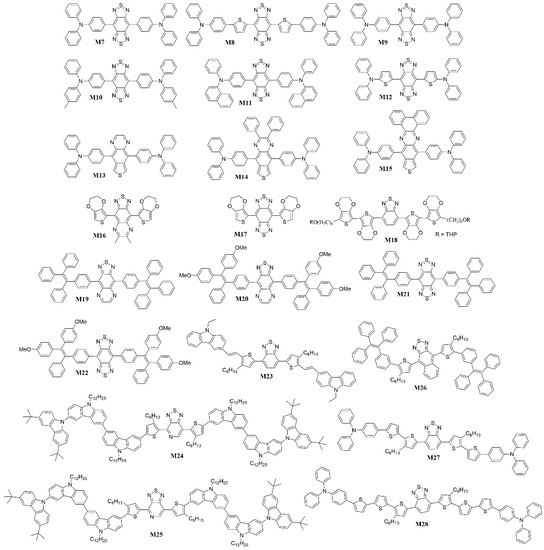
Figure 10.
Chemical structures of M7 to M28.
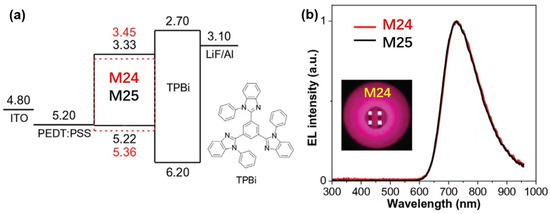
Figure 11.
(a) Schematic energy band diagrams of EL devices using M24 and M25 as nondoped EML; (b) Compared EL spectra of the OLEDs based on M24 and M25. Insert: photograph of M24-based device (adapted from ref. [118]).
In addtion to D-A-D type fluorophores, there are some other materials based on the D-A structure with NIR-emitting. In 2011, Sharbati et al. [121] showed the single layer OLEDs (Figure 12) based on conjugated A-D-A isatin Schiff 3,3′-(4,4′-oxybis (4,1-phenylene) bis (azan-1-yl-1-ylidene)) diindolin-2-one (M29) and 3,3′-(naphthalene-1,5-diylbis (azan-1-yl-1-ylidene)) diindolin-2-one (M30) (Figure 12), which exhibited a red-emitting at 640 nm with an EQE of 0.054% and a NIR-emitting at 700 nm with an EQE of 0.051%, respectively(Figure 13). 3-iminoindolinyl-2-one residue at both sides of chromophores was selected as an acceptor head, while spacer including 4,4′-phenoxybenzene and 1,5-naphthyl was designated as donor segments. Thus, the conjugated backbone between donor and acceptor segments provided the appropriate delocalization and hence could be effective in band gap lowering. They demonstrated that the absorption and electroluminescence properties were considerably affected by the conjugation length with the spectral emission peak of the device shifting from a wavelength of 630 to 700 nm in NIR region. In 2017, Liao et al. [122] presented a novel D-A-A type NIR emitter 7-(4-(di-p-tolylamino)phenyl)benzo[c][1,2,5]thiadiazole-4-carbonitrile (M31) comprising highly polar cyano group together with rigid benzo[c][1,2,5]thiadiazole as tandem acceptor and 4,4′-dimethyltriphenylamine as donor (Figure 12). In merits of the rational design strategy, high photoluminance quantum efficiency (PLQY) of 86%/71% in solution and in film state were successfully achieved. And excellent EQE of 3.8% with peak emission at 692 nm for 15% doped device and 3.1% with peak at 708 nm for nondoped device were successfully obtained. Notably, effciency roll-offs of both doped and nondoped device are flat. In the same year, Yang et al. [123] created far-red (FR)/NIR fluorophores with aggregation-enhanced emission (AEE) (Figure 15) and solution film-forming ability. They linked two butterfly-shaped 3,7-bis(alkoxyphenylbenzothiadiazol)phenothiazines by an alkyl spacer to form a pair of conjoined D-A butterflies 1,6-Bis(3,7-bis(7-(4-((2-ethylhexyl)oxy)phenyl)benzo[c][1,2,5]thiadiazol-4-yl)-10H-phenothiazin-10-yl)hexane (M32) as FR/NIR electroluminescent emitters (Figure 12). The non-doped solution-processed device could emit NIR light of 683 nm with an EQE of 0.57%, and the introduction of the hole-transporting layer PVK resulted in FR light of 659 nm with a remarkably increased EQE of 1.82%. In 2018, Cacialli et al. [124] incorporated a novel triazolobenzothiadiazole-based emitter 6-(2-butyloctyl)-4,8-bis(5′-(2-butyloctyl)-[2,2′-bithiophen]-5-yl)-1H-[1,2,3]triazolo[4′,5′:4,5]benzo[1,2-c][1,2,5]thiadiazole (M33) and a novel polymer matrix that can afford excellent spectral and transport properties (Figure 12). The EL peaked at 840 nm with maximum EQE of ≈ 0.15%.
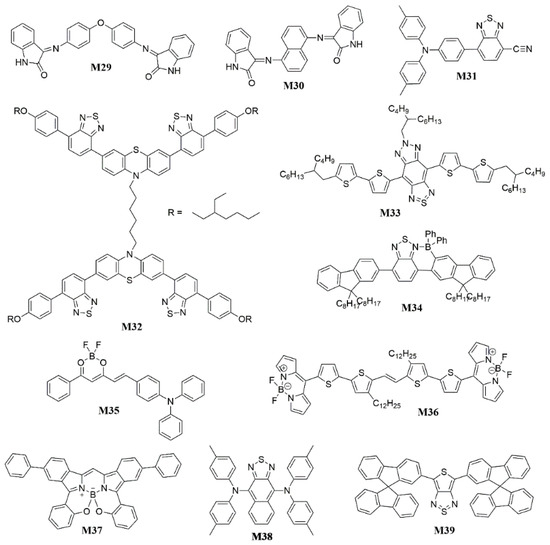
Figure 12.
Chemical structures of M29 to M39.
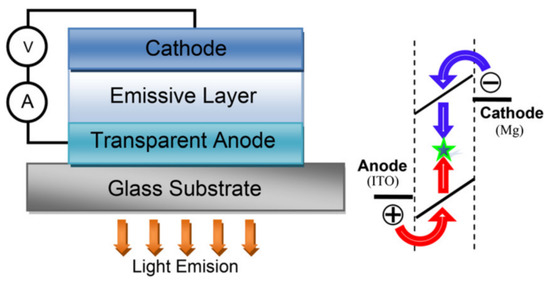
Figure 13.
Structure of a single layer OLED based on M29 and M30. Holes and electrons are recombined in the organic layer that generates light. Cathode was Mg and transparent anode is ITO (adapted from ref. [121]).
Besides utilizing various donors and acceptors moiety, researchers developed a method that binding Lewis acids to a nucleophilic site in the acceptor moiety to increase its electron deficiency. This methodology was used to modulate the absorption, luminescence and charge mobility properties of D-A materials [125,126]. For example, coupling of dative bond formation with C-B bond formation, herein termed borylative fusion, would give chelated Lewis acid adducted with enhanced stability and extended π-conjugation provided by locking neighbouring aromatic units co-planar. Extended π-conjugation will further lower the LUMO energy, whilst raising the HOMO energy level, counteracting the HOMO energy level reduction normally observed on Lewis acid binding to nitrogen-atom. Thus borylative fusion represents a simple methodology for selectively modulating the LUMO energy and reducing the band gap of a material. Based on these computational study and predication, Turner et al. [127] presented a series of BT containing D-A materials with directed C-H electrophilic borylation. Solution processed OLED devices that containing 3-(9,9-dioctyl-9H-fluoren-2-yl)-12,12-dioctyl-6,6-diphenyl-6,12-dihydro-5-thia-4,5aλ4-diaza-6λ4-boraindeno[1,2-k]acephenanthrylene (M34) (Figure 12) as the emitter showed the maximum EQE values of 0.48% with a λmax of 679 nm and a broad emission stretching into the NIR. In 2017, D’Ale’o et al. [128] reported a novel hemicurcuminoid boron difluoride complex (E)-4-(2-(2,2-difluoro-6-phenyl-2H-1λ3,3,2λ4-dioxaborinin-4-yl)vinyl)-N,N-diphenylaniline (M35) containing a TPA donor group, where the acetylacetonate boron difluoride group acted as a strong acceptor (Figure 12). The OLEDs that using M35 as an emitter showed NIR emitting peak at 750 nm with an EQE of 0.4%. In the same year, Cacialli et al. [129] synthesized α,β-unfunctionalised 4,4-difluoro-4-bora-3a,4a-diaza-s-indacene (BODIPY) moieties and constructed A-D-A oligomer (E)-1,2-bis(5′-(5,5-difluoro-5H-4λ4,5λ4-dipyrrolo[1,2-c:2′,1′-f][1,3,2]diazaborinin-10-yl)-4-dodecyl-[2,2′-bithiophen]-5-yl)ethene (M36) emitting in the NIR (Figure 12). The emitting devices incorporating the M36 NIR emitter at a relatively low concentration of 0.5% wt exhibited maximum EQE up to 1.1% with an EL emission peaked at 720 nm. And in 2021, Morimoto et al. [130] also investigated the NIR emission properties of BODIPY derivatives (M37) (Figure 12) and fabricated an NIR-emitting OLED using M37. The device could emit NIR light of 756 nm with an EQE of 1.87%. These proved that BODIPY and its derivatives were a class of potential NIR luminescent materials.
In addition to adjust the groups and structures of fluorescent molecules, researchers have also turned their attention to the host of the OLED device, utilizing the transfer of energy between the host and the emitter to improve the efficiency. In 2018, Yang et al. [131] achieved triplet-singlet energy transfer by the Förster mechanism. The NIR-OLEDs based on N4,N4,N9,N9-tetra-p-tolylnaphtho[2,3-c][1,2,5]thiadiazole-4,9-diamine (M38) were optimized with a sensitizer (Figure 12), where triplet excitons could be utilized via Förster energy transfer process due to the better overlap between the sensitizer emission and the dopant absorption. As a result, the optimized device achieved an EQEmax of 0.77% with electroluminescent peak at 786 nm. In 2022, Wong et al. [132] revealed that the good spectral overlap between the emissions of exciplex co-host and the absorption of emitter (M39) ensured an efficient Förster resonance energy transfer for good NIR emission (Figure 12). The optimal NIR-OLED device achieved a maximum EQE of 5.3% with the EL peaked at 774 nm, which was the best EQE ever reported based on the exciplex co-host with an organic fluorescent dopant.
The photophysical and electroluminescent properties of polymers from M1 to M39 are summarized in Table 2. Most of the NIR organic fluorophores are D-A type or flat π-conjugated molecules. Extending conjugated system, strengthening the D-A interaction and utilizing the energy transfer from the host to emitter are the main methods to construct oligomer fluorescent materials with NIR emitting, which can also guide further design and optimization of NIR emitters for biomedical, security, and communication applications.

Table 2.
Photophysical and electroluminescent properties of some NIR fluorescent organic molecules.
5. NIR Phosphorescent Materials Based on Small Molecules
In general, holes and electrons injected from electrodes to emitters generate excitons, and the excitons are classified into singlet and triplet excitons that are formed at a ratio of 1:3. In the case of fluorescent emitting materials, only singlet excitons can be transformed into photons, and so only 25% internal quantum efficiency (QE) is theoretically possible, where the remaining 75% of non-radiation energy is lost. Therefore, breaking spin statistics to utilize the other 75% triplet energy is the key factor to improving OLED efficiency.
As discussed previously, there are several approaches to design high efficiency materials with NIR emitting through utilizing triplet energy. One of these is to harness the triplet excitons of organic fluorescent materials involves triplet fusion (TF) [133,134,135]. The theoretical maximum singlet exciton production yield through TF is 50%, which would contribute a maximum radiative exciton ratio of up to 62.5%. To enable highly efficient NIR-OLEDs through TF, Qiao et al. [136] used the more feasible approach of efficient TF via the host rather than direct TF from the emitter, since the triplet excitons of the NIR emitter may decay dominantly via non-radiative transition according with the energy gap law. They realized high performance NIR-OLEDs via the high-efficiency TF of a bipolar host doped with a special naphthoselenadiazole emitter 4,9-bis(4-(2,2-diphenylvinyl)phenyl)naphtho[2,3-c][1,2,5]selenadiazole (M40) (Figure 14). Unlike typical NIR organic D-A chromophores, M40 features a non-D-A structure and a very large HOMO/LUMO overlap, displaying strong deep-red to NIR emitting and unique ambipolar character. The corresponding photoluminescence quantum efficiency of NSeD reached 52% in solution and retained 17% in the blend film. The optimized NIR-OLEDs demonstrated a strong emission at 700 nm with a high EQEmax of 2.1% and the EQE remained at around 2% over a wide range of current densities from 18 to 200 mA cm−2. However, this method would lose some of the energy of triplet excitons, so the quantum efficiency in theory is not 100%.
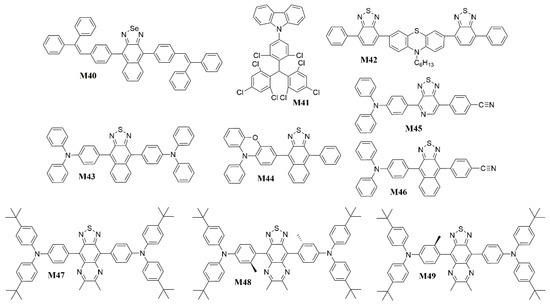
Figure 14.
Chemical structures of M40 to M49.
For standard closed-shell organic semiconductors, holes and electrons occupy the HOMO and LUMO respectively, and recombine to form singlet or triplet excitons. The radical emitter has a SOMO in the ground state, giving an overall spin 1/2 dipole. In the high energy ground state, where both electrons and holes occupy the SOMO level, recombination returns the system to the ground state and does not emit light. However, in 2015, Li et al. [49] achieved selective hole injection into HOMO and electron injection into SOMO to form a fluorescent two-photon excited state with near unit internal quantum efficiency and proposed an open-shell organic molecule 9-(4-(bis(2,4,6-trichlorophenyl)methyl)-3,5-dichlorophenyl)-9H-carbazole (M41) (Figure 14) as an NIR-emitter of OLEDs. When this electron was excited to the lowest SUMO, the SOMO was empty (Figure 15). Thus, transition back of the excited electron to the SOMO is totally spin-allowed. The maximum EQE of the M41-based OLED achieved to be of 2.4% with the emission peak at 692 nm. Then Li et al. [50] optimized the structure of the devices and improved the EQE up to 4.3%. But this approach was very restrictive in terms of molecular design and does not have good universality.
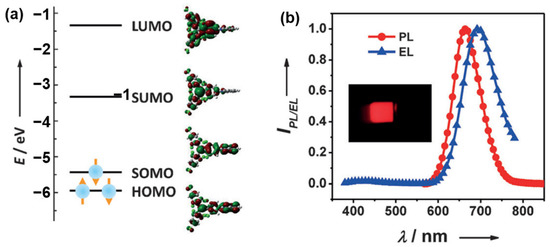
Figure 15.
(a) The energy levels (left panels) and contour plots (right panels) of the molecular orbitals (LUMO, SUMO, SOMO, and HOMO) of M41. (b) The EL spectrum (7 V) of the OLEDs accompanied by the PL spectra of the doped thin film. The inset shows a photograph of the M41-based OLEDs operating at 7 V (adapted from ref. [49]).
The hybridized local and charge-transfer excited state (HLCT) possesses two combined and compatible characteristics with a large transition moment from a local excited (LE) state and a weakly bound exciton from a charge transfer (CT) state [137,138,139]. The former contributes to a high-efficiency radiation of fluorescence, while the latter is responsible for the generation of a high fraction of singlet excitons. The twisting D-A molecule may be an ideal carrier to realize this strategy that may possess two combined and compatible characteristics with large transition moment from LE state and weakly bound exciton from CT state. Based on that, Ma et al. [140] presented a butterfly-shaped NIR D-A compound 10-hexyl-3,7-bis(7-phenylbenzo[c][1,2,5]thiadiazol-4-yl)-10H-phenothiazine (M42) (Figure 14) based on the “HLCT” state (Figure 16), in which phenothiazine served as the electron donor and BT as the electron acceptor. The density functional theory (DFT)-optimized ground-state geometry revealed that the phenothiazine moiety possessed a nonplanar “butterfly-like” structure with a C-S-N-C dihedral angle (θN) of 142° [141]. Furthermore, the phenothiazine and BT groups are twist-linked with a distorted angle (θD-A) of 145°, which is a relatively planar arrangement for D-A compounds. So M42 also has a twisting D-A structure. The EQE of the undoped M42 device is 1.54% and the emission peak is about 700 nm. In 2017, Yang et al. [142] designed a D-π-A-π-D type compound 4,4′-(naphtho[2,3-c][1,2,5]thiadiazole-4,9-diyl)bis(N,N-diphenylaniline) (M43) (Figure 14) with naphthothiadiazole (NZ) as acceptor and TPA as donors. The compound not only has obvious HLCT state feature but also shows aggregation-induced emission (AIE) characteristic. Attributed to its HLCT mechanism and AIE characteristic, M43 acquires an unprecedentedly high photoluminescent quantum yield of 60% in the neat film. The optimized OLEDs achieved a maximum EQE of 3.9% with the emission peak at 696 nm. And Su et al. [143] reported a D-A type luminescent materials 10-phenyl-3-(9-phenylnaphtho[2,3-c][1,2,5]thiadiazol-4-yl)-10H-phenoxazine (M44) (Figure 14) for the applications in efficient NIR-OLEDs, which used HLCT state principle and hot exciton mechanism to achieve the compatible coexistence of high ηPL. Upon a tiny linkage modification, an efficient HLCT emissive state was obtained with the greatly increased coupling between LE and CT states, leading to a significantly enhanced ηPL in film. Consequently, M44 exhibited a very excellent nondoped and doped OLED performances: a nondoped NIR-OLED (ηEQE = 0.82% and λmax = 738 nm). Ma et al. [144] showed [1,2,5]thiadiazolo[3,4-c]pyridine (PT) heterocycle as prototype acceptor unit to construct D-A materials 4-(4-(4-(diphenylamino)phenyl)-[1,2,5]thiadiazolo[3,4-c]pyridin-7-yl)benzonitrile (M45) (Figure 14) with the donor TPA proximal to the N-atom (pyridyl). The choice of the PT heterocycle was based on the pyridine heterocycle is more electron-deficient than BT. Therefore, a red-shift of the absorption and fluorescence could occur due to the strong CT character, resulting in low-energy emission. And the absence of steric hindrance around the nitrogen atom would result in a smaller twist angle between the PT and TPA units, which provided a more planar ground state conformation, increased overlap of the frontier molecular orbitals, ensured large oscillator strengths and facilitated the possibility of high PL efficiencies. Besides, cyano-substituent also was incorporated to further increase the electron-deficient properties of the A moiety to realize a more red-shifted emission. The NIR emission device based on M45 achieved a maximum EQE of 1.47% with emission peak at 700 nm. Then Ma et al. [145] changed the acceptor to NZ with strong electron-withdrawing capability. Moreover, its unique energy level distribution was consistent with “hot exciton” characteristics [146]. Devices based 4-(9-(4-(diphenylamino)phenyl)naphtho[2,3-c][1,2,5]thiadiazol-4-yl)benzonitrile (M46) (Figure 14) exhibited an excellent NIR emission with EL wavelength at 702 nm and a relatively high maximum EQE of 1.2%. These results demonstrate that the cyanophenyl can be used as an ancillary acceptor to construct the narrow-bandgap light-emitting materials with maintenance of PL efficiency in D-A systems, especially for high-efficiency deep-red and NIR fluorescent materials. Constructing the twisting D-A molecule is the point when designing the NIR-emitting materials with HLCT states. In 2021, Miao et al. [147] synthesized three near-infrared emitters (4,4′-(6,7-dimethyl-[1,2,5]thiadiazolo[3,4-g]quinoxaline-4,9-diyl)bis(N,N-bis(4-(tert-butyl)phenyl)aniline) (M47), 4,4′-(6,7-dimethyl-[1,2,5]thiadiazolo[3,4-g]quinoxaline-4,9-diyl)bis(N,N-bis(4-(tert-butyl)phenyl)-3-methylaniline) (M48) and 4-(9-(4-(bis(4-(tert-butyl)phenyl)amino)phenyl)-6,7-dimethyl-[1,2,5]thiadiazolo[3,4-g]quinoxalin-4-yl)-N,N-bis(4-(tert-butyl)phenyl)-3-methylaniline (M49)) (Figure 14), of which M49 had a more obvious HLCT feature based on the influence of the steric hindrance of the methyl substituent. Attributed to their different spatial configurations and luminescence mechanisms, the M47, M48 and M49-doped OLEDs displayed electroluminescence with emission peaks at 728, 693 and 710 nm and maximum EQEs of 1.58%, 1.33% and 3.02%, respectively. It is proved that HLCT mechanism has a positive effect on luminescence efficiency.
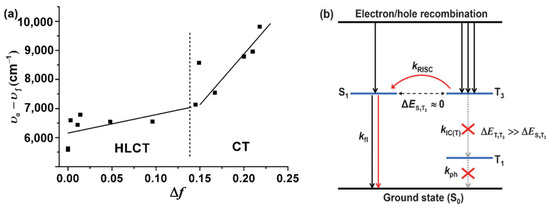
Figure 16.
(a) Linear correlation of the orientation polarization (∆f) of solvent media with the Stokes shift (va-vf; a: absorbed light; f: fluorescence) for M42. (b) Model for exciton relaxation in the EL process. RISC: reverse intersystem crossing; IC(T): internal conversion between the triplet states; fl: fluorescence; ph: phosphorescence (adapted from ref. [140]).
TADF materials have recently attracted great attention as a result of their promising applications in highly efficient OLEDs [148,149]. To achieve efficient TADF, a sufficiently small ∆EST between the S1 and T1 states is desired to facilitate the RISC process. Theoretically, the ∆EST value can be minimized by controlling the separation of the HOMO and LUMO through molecular design. Therefore, TADF is often observed in intramolecular-charge-transfer (ICT) systems containing spatially separation, which meant twisted donor and acceptor moieties. In 2015, Wang et al. [150] reported the first NIR TADF molecule 7,10-bis(4-(diphenylamino)phenyl)-2,3-dicyanopyrazino phenanthrene (M50) (Figure 17), featuring a V-shaped D-π-A-π-D configuration with 2,3-dicyanopyrazino phenanthrene (DCPP) as the electron acceptor, diphenylamine (DPA) as the electron donor, and phenyl rings as π-conjugated bridges, which had a small ∆EST of 0.13 eV. DCPP was selected as the acceptor because of its large and rigid π-conjugated structure with a strong electron-withdrawing capability. DPA was used as the donor for its excellent hole-transporting capability and its steric hindrance that would diminish aggregation-caused quenching (ACQ) [151]. The OLED device employing M50 as a nondoped emitter exhibits a maximum EQE of 2.1% with a 710 nm EL peak. Since then, several researchers have used DCPP and its derivatives as acceptor to construct luminescent molecules with TADF character. Chi et al. [38] synthesized a D-A-D′ type TADF molecule 7-(4-(9H-carbazol-9-yl)phenyl)-10-(4-(diphenylamino)phenyl)-dibenzo Quinoxaline-2,3-dicarbonitrile (M51) (Figure 17) with the DCPP as the electron acceptor, TPA and phenyl carbazole as the different donors. The asymmetric substitution with two different donors leaded to the breaking of molecular symmetry (Figure 18), which resulted in a smaller ΔEST and a larger promotion of SOC to afford a faster kRISC. The non-doped device exhibits a maximum EQE of 5.4% with an emission peak at 718 nm. And Zhao et al. [152] developed a series of TADF molecules (7,10-bis(4-(naphthalen-1-yl(phenyl)amino)phenyl)pyrazino[2,3-f][1,10]phenanthroline-2,3-dicarbonitrile (M52), 7,10-bis(4-(naphthalen-2-yl(phenyl)amino)phenyl)pyrazino[2,3-f][1,10]phenanthroline-2,3-dicarbonitrile (M53), 7,10-bis(4-(diphenylamino)phenyl)pyrazino[2,3-f][1,10]phenanthroline-2,3-dicarbonitrile (M54) and 7,10-bis(4-(di([1,1′-biphenyl]-4-yl)amino)phenyl)pyrazino[2,3-f][1,10]phenanthroline-2,3-dicarbonitrile (M55) comprised of an electron-withdrawing pyrazino[2,3-f][1,10]phenanthroline-2,3-dicarbonitrile (DCPPr) core and various electron-donating triarylamines (Figure 17). Owing to the planar and rigid DCPPr core and intramolecular H-bonding, these molecules tend to adopt horizontal dipole orientation, leading to high quantum efficiency. In consequence, superior EL performances are realized. Their non-doped OLEDs showed NIR lights (716–748 nm) with high EQEmax of 1.0–1.9%. In 2018, Wang et al. [153] developed a new dibenzo[a,c]phenazine-11,12-dicarbonitrile (DBPzDCN) acceptor for designing efficient NIR TADF emitters 3,6-Bis(4-(diphenylamino)phenyl)dibenzo[a,c]phenazine-11,12-dicarbonitrile (M56) by extending the π-conjugated length of the acceptor core (Figure 17). An excellent EQE of 7.68% with the emission peak at 698 nm was achieved in the doped NIR-OLED device based on M56. In 2021, Adachi et al. [154] further increased the electron-deficient by attaching four cyano groups to the acceptor and altered the D-A connection site. The NIR-TADF emitter, 11,12-bis(4-(diphenylamino)phenyl)dibenzo[a,c]phenazine-2,3,6,7-tetracarbonitrile (M57) (Figure 17), had a high photoluminescence quantum yield of over 40% with a peak wavelength at 729 nm. The EL peak wavelength of the M57 based-OLED was 734 nm with an EQE of 13.4%.
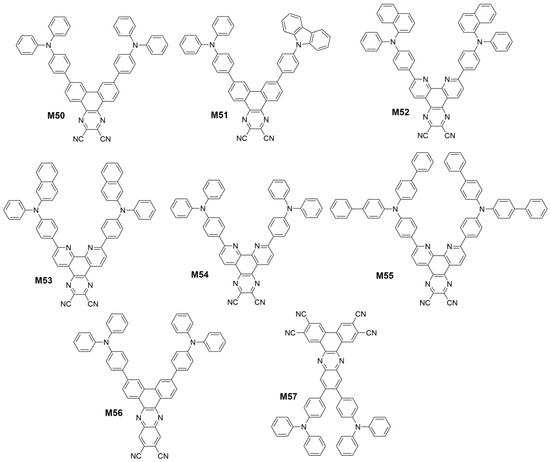
Figure 17.
Chemical structures of M50 to M57.
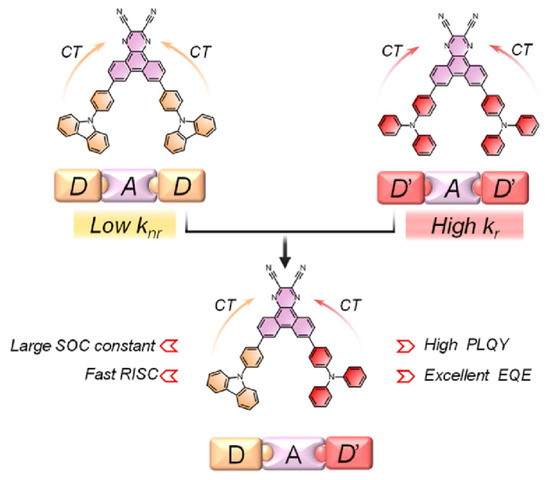
Figure 18.
Molecular design strategy and chemical structures of M51 (adapted from ref. [38]).
In 2017, Liao et al. [155] developed a wedge-shaped D-π-A-π-D emitter 3,4-bis(4-(diphenylamino)phenyl)acenaphtho[1,2-b]pyrazine-8,9-dicarbonitrile (M58) (Figure 19) with TADF property and a small ∆EST of 0.14 eV. Combining an acenaphtho[1,2-b]pyrazine-8,9-dicarbonitrile acceptor (APDC) core coupled with two DPA donor units, because the acenaphthylene based new acceptor APDC possessed stronger electron-withdrawing ability than DCPP, which was due to the trend of forming an aromatic cyclopentadienide structure with six π-electrons in central fuloranthene core [156,157]. M58 based nondoped device exhibited NIR emission with peak wavelength of 777 nm and high EQE of 2.19%, and its doped device achieved excellent EQE of 10.19% with emission wavelength peak at 693 nm. In 2019, Qiao et al. [158] reported a novel design strategy for efficient TADF materials via J-aggregates with strong intermolecular charge transfer. To obtain the desired J-aggregates, they designed two D-A type molecules, 3-(4-(diphenylamino)phenyl)acenaphtho[1,2-b]pyrazine-8,9-dicarbonitrile (M59) and 3-(4-(diphenylamino)phenyl)acenaphtho[1,2-b]quinoxaline-8,9-dicarbonitrile (M60), based on the planar and strong electron-drawing acceptors APDC and acenaphtho[1,2-b]quinoxaline-8,9-dicarbonitrile (AQDC) (Figure 19). The two molecules were gained by futher extending the π-conjugated length of APDC, and a strong electron-donating donor TPA. The nondoped devices with neat M59 and M60 films exhibited strong NIR emissions with maximum EQEs of 3.5% (711 nm) and 5.1% (765 nm), respectively. Then Qiao et al. [159] designed a new NIR TADF emitter 3-(4-(diphenylamino)phenyl)acenaphtho[1,2-b]pyrazino[2,3-e]pyrazine-9,10-dicarbonitrile (M61) (Figure 19) by embedding electron-withdrawing pyrazine in the acceptor APDC to enhance intramolecular CT and realize a red-shift in emission. The doped devices with 1 wt% M61 showed a maximum EQE of 1.35% with an emission peak at 722 nm, and the electroluminescence peak wavelength of the non-doped device was 1010 nm (NIR-II region) with the maximum EQE of 0.003%. Moreover, Bronstein et al. [160] increased the electron-deficient ability of the acceptor by attaching cyano group to APDC, so as to obtain NIR TADF molecule 4-(4-(Diphenylamino)phenyl)acenaphtho[1,2-b]pyrazine-3,8,9-tricarbonitrile (M62) (Figure 19) with stable ICT state. This OLED based on M62 displayed impressive EL wavelength of over 900 nm with maximum EQEs of 0.019%. Fan et al. [161] also synthesized the TADF molecule 3,4-bis(4-(diphenylamino)phenyl)acenaphtho[1,2-b]quinoxaline-8,9,10-tricarbonitrile (M63) (Figure 19) by attaching cyano group to APQC to strengthen the electron-withdrawing capability and reduce the energy gap. The M63-based non-doping device showed EL peak to 910 nm with a maximum EQE of 0.22%. In addition to studying the acceptor, the investigators also modified the donor group. In 2021, Liao et al. [162] designed and synthesized a donor, N,N-diphenyl-9,9′-spirobi[fluorene]-2-amine (SDPA), by attaching an 9,9′-spirobifluorene (SBF) moiety into a diphenylamine block. Then these researchers incorporated SDPA and APDC to construct a NIR TADF emitter 3-(4-(9,9′-spirobi[fluorene]-3-yl(phenyl)amino)phenyl)acenaphtho[1,2-b]pyrazine-8,9-dicarbonitrile (M64) (Figure 19). When M64 was applied in non-doped device, the highest EQE was 2.55% with a NIR emission peaked at 782 nm. The result indicate that donor modification is also an effective strategy to achieve an efficient NIR emission.
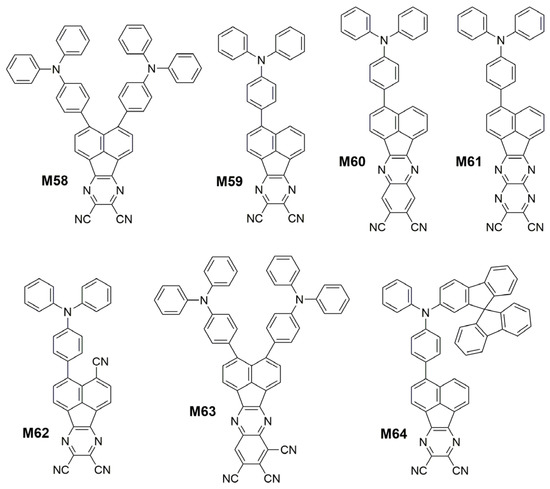
Figure 19.
Chemical structures of M58 to M64.
In addition to DCPP, APDC and their derivatives, the researchers also studied other acceptor groups that applicable to D-A NIR TADF molecules. In 2017, Qiao et al. [163] utilized the TADF molecule possessing a small ∆EST of 0.27 eV as the sensitizing host to harvest triplet excitons in devices NIR-OLEDs doped with a special naphthoselenadiazole emitter 4,9-bis(4-(diphenylamino)phenyl)-naphtho[2,3-c][1,2,5]selenadiazole (M65) (Figure 20) possessing a large HOMO/LUMO overlap and displayed a strong NIR fluorescence. The optimized NIR-FOLEDs achieved high EQEs up to 2.65% with emission peak at 730 nm. Wang et al. [164] presented a D-π-A type TADF compound 2-(4′-(diphenylamino)biphenyl-4-yl)quinoxaline-6,7-dicarbonitrile (M66) (Figure 20) with strong NIR emission feature. The TPA and quinoxaline-6,7-dicarbonitrile (QCN) were employed as electron donor and acceptor, respectively. The crooked π-conjugation geometry and potential intermolecular interaction that pointed at the edge of QCN moiety may promote M66 to adopt edge to edge aggregation and eliminate face to face or π-π stacking, which should result in the emission red-shift and relatively weaker luminescence quenching. And the large steric hindrance of TPA can certainly weaken dipole-dipole interaction and enhance the emission (Figure 21). The non-doped NIR-OLEDs achieve excellent EQEs up to 3.9% with emission peak at 728 nm. In 2018, Data et al. [165] synthesized a NIR TADF emitter 4,9-bis(4-(diphenylamino)phenyl)-2,7-bis(2-ethylhexyl)benzo[lmn][3,8]phenanthroline-1,3,6,8(2H,7H)-tetraone (M67) (Figure 20) with a naphthalene diimide core disubstituted with TPA. There is a state existing due to a more planar, conjugated geometry having a high degree of excitonic delocalization. In the planar configuration, the lowest energy triplet state of the molecule is a unique molecular state of low energy, 3LECon, onset at 1.79 eV. So the OLED based on M67 showed NIR emission with peak wavelength of 740 nm and EQE of 2.4%. Since BT groups were previously reported to be used as acceptor for D-A-D type NIR polymer [82], then Promarak et al. [166] utilized the 5,6-dicyano[2,1,3]benzothiadiazole (CNBT) as an acceptor core due to the presence of imine and multiple electron-withdrawing cyano groups. By connecting two TPA at the end of the CNBT unit, a simple D-A-D type NIR molecule 4,7-bis(4-(diphenylamino)phenyl)benzo[c][1,2,5]thiadiazole-5,6-dicarbonitrile (M68) (Figure 20) with a ΔEST of 0.06 eV was obtained. The electroluminescent device using M68 exhibited an excellent performance with EQEmax of 6.57% and a peak wavelength of 712 nm. In 2022, Ge et al. [167] developed two NIR TADF fluorophores 6-(4-(tert-butyl)phenyl)-8-(4-(diphenylamino)phenyl)-6H-indolo[2,3-b]quinoxaline-2,3-dicarbonitrile (M69) and 6-(4-(tert-butyl)phenyl)-8-(4-(naphthalen-2-yl(phenyl)amino)phenyl)-6H-indolo[2,3-b]quinoxaline-2,3-dicarbonitrile (M70) by connecting N,N-diphenylnaphthalen-2-amine and TPA with a novel electron withdrawing unit 6-(4-(tert-butyl)phenyl)-6H-indolo[2,3-b]quinoxaline-2,3-dicarbonitrile (Figure 20). These emitters have the AIE effect, J-aggregate with intra- and intermolecular CN⋯⋯H-C and C-H⋯⋯π interactions, and the large center-to-center distance in the solid state can improve the emission efficiency of thin films and non-doped OLEDs. The M69 in non-doped device exhibits the state of the EQEmax of 6.61% with EL peak located at 709 nm, and the maximum EQE of the M70-based OLED is 9.44% with EL peak at 711 nm. And Tang et al. [39] reported a NIR molecule 2-(4-cyano-8-(4-(diphenylamino)phenyl)-[1,3]dithiolo[4′,5′:4,5]benzo[1,2-c][1,2,5]thiadiazol-6-ylidene)malononitrile (M71) (Figure 20) with D-A structure and AIE property, which used electron-deficient dithiofluorene fused with benzothiadiazole as an acceptor. When applied in non-doped OLED devices, M71 showed the EQEmax of 2.2% at 802 nm. In the trinary system (host, sensitizer, and emitter), an outstanding EQEmax of 14.3% peaked at 750 nm has been achieved.
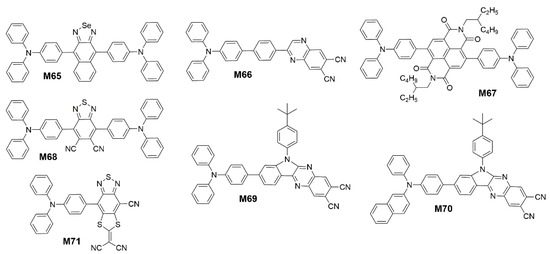
Figure 20.
Chemical structures of M65 to M71.
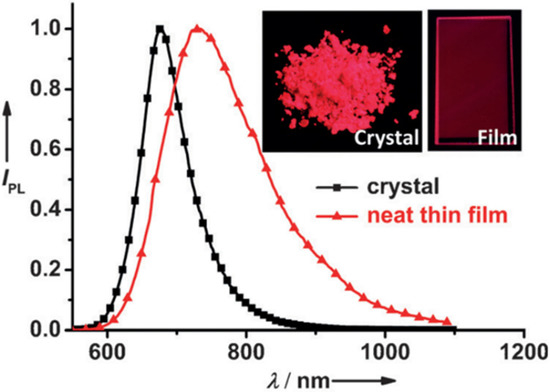
Figure 21.
PL spectra of M66 crystal and neat thin film at room temperature. Inset: images of crystal and neat thin film under UV irradiation (λex = 365 nm) (adapted from ref. [165]).
In addition to adjust the ∆EST by enlarging the conjugated system, inserting heteroatoms or attaching cyano groups to the aromatic ring, the researchers also constructed D-A-D type NIR TADF molecules by boron bonding compounds. In 2018, Adachi et al. [168] designed a NIR TADF fluorophore ethyl 4,6-bis((E)-4-(diphenylamino)styryl)-2,2-difluoro-2H-1λ3,3,2λ4-dioxaborinine-5-carboxylate (M72) (Figure 22) using a boron difluoride curcuminoid derivative with amplified spontaneous emission (ASE) property. The strong spatial overlap between the hole wave function and the electron wave function describing the optical transition in M72 is consistent with the large oscillation intensity, high radiative decay rate and ASE property of the molecule. The nonadiabatic coupling effect between the low altitude excited states of the D-A-D molecule is the reason why the M72 has effective vibration and spin orbit coupling assisted TADF activity. The M72-based NIR OLEDs (Figure 23) with an EQEmax of nearly 10% peaked at 721 nm. And then they [169] synthesized a dimeric borondifluoride curcuminoid derivative 4,4′,4″,4‴-((1E,1′E,1″E,1‴E)-(2,2,2′,2′-tetrafluoro-2H,2′H-1λ3,1′λ3,2λ4,2′λ4-[5,5′-bi(1,3,2-dioxaborinine)]-4,4′,6,6′-tetrayl)tetrakis(ethene-2,1-diyl))tetrakis(N,N-diphenylaniline) (M73) (Figure 22) containing TPA donor groups and acetylacetonate borondifluoride acceptor units with ASE properties. This M73 had an electron withdrawing group in the meso position instead of the ester function in M72, where the strong excitonic coupling effects occurred that should result in a substantial shift of the emission toward longer wavelengths. The most efficient OLED based on M73 exhibited an EQEmax of 5.1% for an emission wavelength of 758 nm. In 2020, Kéna-Cohen et al. [170] modified the structure of M72 by replacing the phenyl group of M72 with methyl phenyl to obtain the molecule ethyl 4,6-bis((E)-4-(di-p-tolylamino)styryl)-2,2-difluoro-2H-1λ3,3,2λ4-dioxaborinine-5-carboxylate (M74) (Figure 22), which resulted in a bathochromic shift to longer wavelengths and improved efficiency at high doping concentrations. The M74 was used as the dopant to demonstrate pure NIR-emitting OLEDs with an EQEmax of up to 3.8% peaked at 840 nm and a spectral full-width at half-maximum of < 40 nm. In 2022, Yang et al. [171] designed two TADF emitters (10,10′-(((4R)-1′λ3,4λ4-spiro[dinaphtho[2,1-d:1′,2′-f][1,3,2]dioxaborepine-4,2′-[1,3,2]dioxaborinine]-4′,6′-diyl)bis(4,1-phenylene))bis(9,9-dimethyl-9,10-dihydroacridine) (M75) and 10,10′-(((4R)-8,9,10,11,12,13,14,15-octahydro-1′λ3,4λ4-spiro[dinaphtho[2,1-d:1′,2′-f][1,3,2]dioxaborepine-4,2′-[1,3,2]dioxaborinine]-4′,6′-diyl)bis(4,1-phenylene))bis(9,9-dimethyl-9,10-dihydroacridine) (M76)) (Figure 22) with tetracoordinate boron geometries. The chiral group of binaphtholate and octa-hydro-binaphtholate were integrated to construct the twisted tetrahedron-like emitters. The M75 and M76 with the twisted configurations lead to mechanochromism, piezochromism, and AIE emission. The nondoped OLEDs devices based on M75 and M76 revealed the NIR emission (peaking at 716 nm and 700 nm) with an EQEmax of 1.9% and 0.7%, respectively. The red-shifted emission of devices based on M75 is attributed to the stronger charge transfer feature of M75.
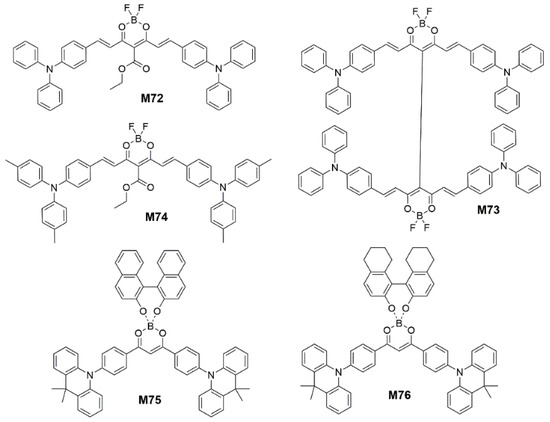
Figure 22.
Chemical structures of M72 to M76.

Figure 23.
(a) Photographs under UV light (each sample: 1.5 × 2 cm2) of M72; (b) Schematic representation and energy diagram of the NIR OLEDs (adapted from ref. [171]).
In Table 3, the photophysical and electroluminescent properties of polymers from M40 to M76 are summarized. It can be seen that organic fluorophore that can break the spin statistics to make use of both singlet and triplet excitons is a kind of promising NIR electroluminescent materials. However, the above methods have certain limitations in molecular design, which hinder the research processes and practical applications of NIR electroluminescent materials.

Table 3.
Photophysical and electroluminescent properties of some NIR phosphorescent organic molecules.
LECs are also a kind of solid-state lighting device, but with a single emission layer inserted between the anode and cathode, rather than a multi-layered structure made up of several layers of components like OLEDs [172]. However, most of the emitters of NIR LECs are transition metal complexes [173,174,175], only a few of heavy metal-free emitters have been reported [176]. And we have also done some research work on polymers [20]. Even utilizing the transition metal complexes with triplet exiton, the efficiency of NIR LECs is generally low (less than 1%), far behind that of OLED [177], so NIR LECs need to be further developed.
6. Conclusions
Shifting the spectral range of OLEDs/PLEDs from the visible to the NIR region of the electromagnetic spectrum is of great interest. To date, much efforts have been made to develop NIR phosphorescent OLEDs/PLEDs using transition metal complexes. However, high costs, limited resources of phosphorescent materials, and efficiency roll-offs at high current densities remain challenges for their applications in long-term mass production. To reduce cost and improve environmental sustainability, the development of highly efficient OLEDs/PLEDs that does not rely on heavy metal-containing compounds remains an important need. As an alternative material system, the “heavy metal-free” NIR fluorophores have been widely investigated for their cost advantage and versatility in tuning molecules. However, the EQE of traditional organic near-infrared fluorescent OLEDs is generally about 0.1% or even lower due to low exciton utilization rate and low fluorescence quantum yield in solid state, which has become an almost insurmountable obstacle for their further development. Therefore, several strategies have been proposed to realize high quantum efficiency in pure organic dyes by utilizing triplet energy. Nevertheless, this research field is still in its infancy, and while many examples harvesting triplet excitons are reported, only a few studies have focused on their NIR emission, particularly in terms of OLEDs/PLEDs applications.
This review summarized the development of NIR emission materials based on organic fluorophores, and their applications for OLEDs/PLEDs. Conjugated polymers and traditional organic small molecules just use singlet excitons and present relatively low internal quantum yield. While organic fluorophores with doublet, TTA, HLCT or TADF state utilize triplet excitons directly and theoretical internal quantum yield can reach to 100%. The most remarkable is the NIR TADF material. Devices based on the molecules with TADF properties have achieved a maximum EL wavelengths of more than 1000 nm, and the OLED based on the TADF molecule has achieved a maximum EQE of more than 13%, so TADF channels with triplet states in the near infrared region are expected to be the next research topic. It is hoped that this review will contribute to the singularity of TADF emitter design, which will lead to practical device performance through efficient triplet utilization.
On the other hand, these research results provide us some points to design NIR-emitting organic fluorophores like constructing twisted D-A structure rather than just enlarging π-conjugated system to minimize the ∆EST value, and attaching cyano groups to the aromatic ring or utilizing boron bonding units rather than just inserting heteroatoms to enhance the electron-withdrawing capability of acceptor.
Some excellent works have been done the field of NIR OLEDs, the quantum yield of the material, the electroluminescence wavelength, stability and EQE of the device have been greatly improved. However, the types of high-performance organic NIR luminescence materials are still few, and the problems of low device efficiency and efficiency roll-down are still the bottlenecks in the development and application. The future directions may include the following fields: (1) develop new and efficient organic near infrared luminescence materials; (2) study the relationship between molecular structure and electroluminescence properties; (3) reveal the relationship between device properties and device processing technology, and host and guest energy levels; (4) realize the application of organic NIR luminescence materials and devices in military, optical fiber communication, biomedical imaging and other fields.
Author Contributions
Conceptualization, W.X., M.P. and W.S.; methodology, W.X., M.P. and W.S.; validation, W.X., M.P. and W.S.; formal analysis, W.X. and C.Z.; investigation, W.X., C.Z. and Y.F.; resources, W.X., C.Z. and Y.F.; writing—original draft preparation, W.X.; writing—review and editing, M.P. and W.S.; visualization, W.X., M.P. and W.S.; supervision, W.X., M.P. and W.S.; project administration, W.X. and W.S.; funding acquisition, W.X. and W.S. All authors have read and agreed to the published version of the manuscript.
Funding
This research was funded by the Hainan Provincial Natural Science Foundation of China, grant number 222RC654 and 521QN0886; the Science and Research Project of Education Department of Hainan Province, grant number Hnky2021-27 and Open Funding of Jiangsu Key Laboratory of Environmentally Friendly Polymeric Materials, grant number PML2002.
Institutional Review Board Statement
Not applicable.
Informed Consent Statement
Not applicable.
Data Availability Statement
Not applicable.
Acknowledgments
This work was supported by the Science and Technology Department of Hainan Province; the Education Department of Hainan Province and Jiangsu Key Laboratory of Environmentally Friendly Polymeric Materials.
Conflicts of Interest
The authors declare no conflict of interest. The funders had no role in the design of the study; in the collection, analyses, or interpretation of data; in the writing of the manuscript; or in the decision to publish the results.
References
- Tang, C.W.; Van Slyke, S.A. Organic electroluminescent diodes. Appl. Phys. Lett. 1987, 51, 913–915. [Google Scholar] [CrossRef]
- Kim, J.-H.; Park, J.-W. Intrinsically stretchable organic light-emitting diodes. Sci. Adv. 2021, 7, 9715. [Google Scholar] [CrossRef] [PubMed]
- Su, R.; Park, S.H.; Ouyang, X.; Ahn, S.I.; McAlpine, M.C. 3D-printed flexible organic light-emitting diode displays. Sci. Adv. 2022, 8, 8798. [Google Scholar] [CrossRef] [PubMed]
- Song, H.; Song, Y.J.; Hong, J.; Kang, K.S.; Yu, S.; Cho, H.; Kim, J.; Lee, S. Water stable and matrix addressable OLED fiber textiles for wearable displays with large emission area. NPJ Flex Electron. 2022, 6, 66. [Google Scholar] [CrossRef]
- Choi, S.; Kang, C.; Byun, C.-W.; Cho, H.; Kwon, B.-H.; Han, J.-H.; Yang, J.-H.; Shin, J.-W.; Hwang, C.-S.; Cho, N.S.; et al. Thin-film transistor-driven vertically stacked full-color organic light-emitting diodes for high-resolution active-matrix displays. Nat. Commun. 2020, 11, 2732. [Google Scholar] [CrossRef] [PubMed]
- Zhang, H.; Su, Q.; Chen, S. Quantum-dot and organic hybrid tandem light-emitting diodes with multi-functionality of full-color-tunability and white-light-emission. Nat. Commun. 2020, 11, 2826. [Google Scholar] [CrossRef]
- Hu, Y.X.; Miao, J.; Hua, T.; Huang, Z.; Qi, Y.; Zou, Y.; Qiu, Y.; Xia, H.; Liu, H.; Cao, X.; et al. Efficient selenium-integrated TADF OLEDs with reduced roll-off. Nat. Photon. 2022, 16, 803–810. [Google Scholar] [CrossRef]
- Liu, H.; Fu, Y.; Tang, B.Z.; Zhao, Z. All-fluorescence white organic light-emitting diodes with record-beating power efficiencies over 130 lm W−1 and small roll-offs. Nat. Commun. 2022, 13, 5154. [Google Scholar] [CrossRef] [PubMed]
- Chen, H.; Liu, L.; Qian, K.; Liu, H.; Wang, Z.; Gao, F.; Qu, C.; Dai, W.; Lin, D.; Chen, K.; et al. Bioinspired large Stokes shift small molecular dyes for biomedical fluorescence imaging. Sci. Adv. 2022, 8, 3289. [Google Scholar] [CrossRef]
- Zhang, Y.; Zhao, W.; Chen, Y.; Yuan, H.; Fang, H.; Yao, S.; Zhang, C.; Xu, H.; Li, N.; Liu, Z.; et al. Rational construction of a reversible arylazo-based NIR probe for cycling hypoxia imaging in vivo. Nat. Commun. 2021, 12, 2772. [Google Scholar] [CrossRef]
- Sisak, M.A.A.; Louis, F.; Aoki, I.; Lee, S.H.; Chang, Y.-T.; Matsusaki, M. A near-infrared organic fluorescent probe for broad applications for blood vessels imaging by high-throughput screening via 3D-blood vessel models. Small Methods 2021, 5, 2100338. [Google Scholar] [CrossRef] [PubMed]
- Wang, L.G.; Barth, C.W.; Kitts, C.H.; Mebrat, M.D.; Montaño, A.R.; House, B.J.; McCoy, M.E.; Antaris, A.L.; Galvis, S.N.; McDowall, I.; et al. Near-infrared nerve-binding fluorophores for buried nerve tissue imaging. Sci. Transl. Med. 2021, 12, 0712. [Google Scholar] [CrossRef] [PubMed]
- Salem, D.P.; Gong, X.; Liu, A.T.; Akombi, K.; Strano, M.S. Immobilization and function of NIR-fluorescent carbon nanotube sensors on paper substrates for fluidic manipulation. Anal. Chem. 2020, 92, 916–923. [Google Scholar] [CrossRef] [PubMed]
- Nißler, R.; Bader, O.; Dohmen, M.; Walter, S.G.; Noll, C.; Selvaggio, G.; Groß, U.; Kruss, S. Remote near infrared identification of pathogens with multiplexed nanosensors. Nat. Commun. 2020, 11, 5995. [Google Scholar] [CrossRef] [PubMed]
- Lan, Z.; Lei, Y.; Chan, W.K.E.; Chen, S.; Luo, D.; Zhu, F. Near-infrared and visible light dual-mode organic photodetectors. Sci. Adv. 2020, 6, 8065. [Google Scholar] [CrossRef]
- Chen, Y.; Pei, P.; Lei, Z.; Zhang, X.; Yin, D.; Zhang, F. A Promising NIR-II Fluorescent Sensor for Peptide-Mediated LongTerm Monitoring of Kidney Dysfunction. Angew. Chem. Int. Ed. 2021, 60, 15809–15815. [Google Scholar] [CrossRef] [PubMed]
- Bideh, B.N.; Shahroosvand, H.; Sousaraei, A.; Cabanillas-Gonzalez, J. A near infrared light emitting electrochemical cell with a 2.3 V turn-on voltage. Sci. Rep. 2019, 9, 228. [Google Scholar] [CrossRef]
- Liu, Q.; Kanahashi, K.; Matsuki, K.; Manzhos, S.; Feron, K.; Bottle, S.E.; Tanaka, K.; Nanseki, T.; Takenobu, T.; Tanaka, H.; et al. Triethylene Glycol Substituted Diketopyrrolopyrroleand Isoindigo-Dye Based Donor–Acceptor Copolymers for Organic Light-Emitting Electrochemical Cells and Transistors. Adv. Electron. Mater. 2020, 6, 1901414. [Google Scholar] [CrossRef]
- Mone, M.; Tang, S.; Genene, Z.; Murto, P.; Jevric, M.; Zou, X.; Ràfols-Ribé, J.; Abdulahi, B.A.; Wang, J.; Mammo, W.; et al. Near-Infrared Emission by Tuned Aggregation of a Porphyrin Compound in a Host–Guest Light-Emitting Electrochemical Cell. Adv. Opt. Mater. 2021, 9, 2001701. [Google Scholar] [CrossRef]
- Xiong, W.; Tang, S.; Murto, P.; Zhu, W.; Edman, L.; Wang, E. Combining Benzotriazole and Benzodithiophene Host Units in Host-Guest Polymers for Efficient and Stable Near-Infrared Emission from Light-Emitting Electrochemical Cells. Adv. Opt. Mater. 2019, 7, 1900280. [Google Scholar] [CrossRef]
- Vasilopoulou, M.; Fakharuddin, A.; Arquer, F.P.G.; Georgiadou, D.G.; Kim, H.; Yusoff, A.R.M.; Gao, F.; Nazeeruddin, M.K.; Bolink, H.J.; Sargent, E.H. Advances in solution-processed near-infrared light-emitting diodes. Nat. Photon. 2021, 15, 656–669. [Google Scholar] [CrossRef]
- Sun, Y.; Sun, W.; Liu, W.; Li, X.; Yin, J.; Zhou, L. Efficient Nondoped Pure Red/Near-Infrared TADF OLEDs by Designing and Adjusting Double Quantum Wells Structure. ACS Appl. Electron. Mater. 2022, 4, 3615–3622. [Google Scholar] [CrossRef]
- Tu, L.; Xie, Y.; Li, Z.; Tang, B. Aggregation-induced emission: Red and near-infrared organic light-emitting diodes. SmartMat 2021, 2, 326–346. [Google Scholar] [CrossRef]
- Xiao, Y.; Wang, H.; Xie, Z.; Shen, M.; Huang, R.; Miao, Y.; Liu, G.; Yu, T.; Huang, W. NIR TADF emitters and OLEDs: Challenges, progress, and perspectives. Chem. Sci. 2022, 13, 8906–8923. [Google Scholar] [CrossRef]
- Kelley, M.L.; Letton, J.; Simin, G.; Ahmed, F.; Love-Baker, C.A.; Greytak, A.B.; Chandrashekhar, M.V.S. Photovoltaic and Photoconductive Action Due to PbS Quantum Dots on Graphene/SiC Schottky Diodes from NIR to UV. ACS Appl. Electron. Mater. 2020, 2, 134–139. [Google Scholar] [CrossRef]
- Boopathi, K.M.; Hanmandlu, C.; Singh, A.; Chen, Y.-F.; Lai, C.S.; Chu, C.W. UV- and NIR-Protective Semitransparent Smart Windows Based on Metal Halide Solar Cells. ACS Appl. Energy Mater. 2018, 1, 632–637. [Google Scholar] [CrossRef]
- Chen, C.; Zheng, S.; Song, H. Photon management to reduce energy loss in perovskite solar cells. Chem. Soc. Rev. 2021, 50, 7250–7329. [Google Scholar] [CrossRef]
- Leccardi, M.J.I.A.; Chenais, N.A.L.; Ferlauto, L.; Kawecki, M.; Zollinger, E.G.; Ghezzi, D. Photovoltaic organic interface for neuronal stimulation in the near-infrared. Commun. Mater. 2020, 1, 21. [Google Scholar] [CrossRef]
- Zhou, X.; Wang, R.; Xiang, G.; Jiang, S.; Li, L.; Luo, X.; Pang, Y.; Tian, Y. Multi-parametric thermal sensing based on NIR emission of Ho(III) doped CaWO4 phosphors. Opt. Mater. 2017, 66, 12–16. [Google Scholar] [CrossRef]
- Shang, K.; He, W.; Sun, J.; Hu, D.; Liu, J. Synthesis, crystal structure and Near-infrared luminescence of rare earth metal (YIII, ErIII, HoIII) complexes containing semi-rigid tricarboxylic acid ligand. J. Mol. Struct. 2021, 1246, 131097. [Google Scholar] [CrossRef]
- Wu, J.; Pan, X.; Wen, L.; Luo, L.; Zhou, Q. Design a rare-earth free broadband NIR phosphor and improve the photoluminescence intensity by alkali charge compensation. Mater. Today Commun. 2022, 30, 102997. [Google Scholar] [CrossRef]
- Rao, V.R.; Jayasankar, C.K. Spectroscopic investigations on multi-channel visible and NIR emission of Sm3+-doped alkali-alkaline earth fluoro phosphate glasses. Opt. Mater. 2019, 91, 7–16. [Google Scholar] [CrossRef]
- Wang, S.-F.; Su, B.-K.; Wang, X.-Q.; Wei, Y.-C.; Kuo, K.-H.; Wang, C.-H.; Liu, S.-H.; Liao, L.-S.; Hung, W.-Y.; Fu, L.-W.; et al. Polyatomic molecules with emission quantum yields >20% enable efficient organic light-emitting diodes in the NIR(II) window. Nat. Photon. 2022, 16, 843–850. [Google Scholar] [CrossRef]
- Xiong, W.; Meng, F.; You, C.; Wang, P.; Yu, J.; Wu, X.; Pei, Y.; Zhu, W.; Wang, Y.; Su, S. Molecular Isomeric Engineering of Naphtyl-quinoline-Containing Dinuclear Platinum Complexes to Tune Emission from Deep Red to Near Infrared. J. Mater. Chem. C 2019, 7, 630–638. [Google Scholar] [CrossRef]
- Zhu, Z.-L.; Tan, J.-H.; Chen, W.-C.; Yuan, Y.; Fu, L.-W.; Cao, C.; You, C.-J.; Ni, S.-F.; Chi, Y.; Lee, C.-S. High Performance NIR OLEDs with Low Efficiency Roll-Off by Leveraging Os(II) Phosphors and Exciplex Co-Host. Adv. Funct. Mater. 2021, 31, 2102. [Google Scholar] [CrossRef]
- Penconi, M.; Kajjam, A.B.; Jung, M.-C.; Cazzaniga, M.; Baldoli, C.; Ceresoli, D.; Thompson, M.E.; Bossi, A. Advancing Near-Infrared Phosphorescence with Heteroleptic Iridium Complexes Bearing a Single Emitting Ligand: Properties and Organic Light-Emitting Diode Applications. Chem. Mater. 2022, 34, 574–583. [Google Scholar] [CrossRef]
- Hu, Y.; Yuan, Y.; Shi, Y.; Lin, J.; Jiang, Z.; Liao, L. Efficient near-infrared organic light-emitting diodes based on a bipolar host. J. Mater. Chem. C 2018, 6, 1407–1412. [Google Scholar] [CrossRef]
- Liu, Y.; Yang, J.; Mao, Z.; Chen, X.; Yang, Z.; Ge, X.; Peng, X.; Zhao, J.; Su, S.-J.; Chi, Z. Asymmetric Thermally Activated Delayed Fluorescence Emitter for Highly Efficient Red/Near-Infrared Organic Light-Emitting Diodes. ACS Appl. Mater. Interfaces 2022, 14, 33606–33613. [Google Scholar] [CrossRef]
- Yu, Y.; Xing, H.; Liu, D.; Zhao, M.; Sung, H.H.-Y.; Williams, I.D.; Lam, J.W.Y.; Xie, G.; Zhao, Z.; Tang, B.Z. Solution-processed AIEgen NIR OLEDs with EQE Approaching 15%. Angew. Chem. Int. Ed. 2022, 61, 202204279. [Google Scholar] [CrossRef]
- Yang, R.Q.; Tian, R.Y.; Yan, J.G.; Zhang, Y.; Yang, J.; Hou, Q.; Yang, W.; Zhang, C.; Cao, Y. Deep-Red Electroluminescent Polymers: Synthesis and Characterization of New Low-Band-Gap Conjugated Copolymers for Light-Emitting Diodes and Photovoltaic Devices. Macromolecules 2005, 38, 244–253. [Google Scholar] [CrossRef]
- Li, P.; Fenwick, O.; Yilmaz, S.; Breusov, D.; Caruana, D.J.; Allard, S.; Scherf, U.; Cacialli, F. Dual functions of a novel low-gap polymer for near infrared photovoltaics and light-emitting diodes. Chem. Commun. 2011, 47, 8820–8822. [Google Scholar] [CrossRef] [PubMed]
- Crossley, D.L.; Urbano, L.; Neumann, R.; Bourke, S.; Jones, J.; Dailey, L.A.; Green, M.; Humphries, M.J.; King, S.M.; Turner, M.L.; et al. Post-polymerization C−H Borylation of Donor−Acceptor Materials Gives Highly Efficient Solid State Near-Infrared Emitters for Near-IROLEDs and Effective Biological Imaging. ACS Appl. Mater. Interfaces 2017, 9, 28243–28249. [Google Scholar] [CrossRef] [PubMed]
- Du, X.; Qi, J.; Zhang, Z.; Ma, D.; Wang, Z.Y. Efficient Non-doped Near Infrared Organic Light-Emitting Devices Based on Fluorophores with Aggregation-Induced Emission Enhancement. Chem. Mater. 2012, 24, 2178–2185. [Google Scholar] [CrossRef]
- Cao, L.; Li, J.; Zhu, Z.-Q.; Huang, L.; Li, J. Stable and Efficient Near-Infrared Organic Light-Emitting Diodes Employing a Platinum(II) Porphyrin Complex. ACS Appl. Mater. Interfaces 2021, 13, 60261–60268. [Google Scholar] [CrossRef] [PubMed]
- Chen, Z.; Zhang, H.; Wen, D.; Wu, W.; Zeng, Q.; Chen, S.; Wong, W.-Y. A simple and efficient approach toward deep-red to near-infrared-emitting iridium(III) complexes for organic light-emitting diodes with external quantum efficiencies of over 10%. Chem. Sci. 2020, 11, 2342–2349. [Google Scholar] [CrossRef] [PubMed]
- Zhang, H.; Chen, Z.; Zhu, L.; Wu, Y.; Xu, Y.; Chen, S.; Wong, W.-Y. High Performance NIR OLEDs with Emission Peak Beyond 760 nm and Maximum EQE of 6.39%. Adv. Optical Mater. 2022, 10, 2200111. [Google Scholar] [CrossRef]
- Nalaoh, P.; Sungworawongpana, N.; Chasing, P.; Waengdongbung, W.; Funchien, P.; Kaiyasuan, C.; Sudyoadsuk, T.; Promarak, V. A Dimeric π-Stacking of Anthracene Inducing Efficiency Enhancement in Solid-State Fluorescence and Non-Doped Deep-Blue Triplet-Triplet Annihilation Organic Light-Emitting Diodes. Adv. Opt. Mater. 2021, 9, 2100500. [Google Scholar] [CrossRef]
- Chen, C.-H.; Li, Y.-S.; Fang, S.-C.; Lin, B.-Y.; Li, C.-Y.; Liao, Y.-C.; Chen, D.-G.; Chen, Y.-R.; Kung, Y.-C.; Wu, C.-C.; et al. High-Performance Deep-Blue OLEDs Harnessing Triplet-Triplet Annihilation Under Low Dopant Concentration. Adv. Photonics Res. 2022, 2200204. [Google Scholar] [CrossRef]
- Gu, Q.; Abdurahman, A.; Friend, R.H.; Li, F. Polymer Light Emitting Diodes with Doublet Emission. J. Phys. Chem. Lett. 2020, 11, 5638–5642. [Google Scholar] [CrossRef]
- Liu, C.-H.; Hamzehpoor, E.; Sakai-Otsuka, Y.; Jadhav, T.; Perepichka, D.F. A Pure-Red Doublet Emission with 90% Quantum Yield: Stable, Colorless, Iodinated Triphenylmethane Solid. Angew. Chem. Int. Ed. 2020, 59, 23030–23034. [Google Scholar] [CrossRef]
- Zhong, Z.; Zhu, X.; Wang, X.; Zheng, Y.; Geng, S.; Zhou, Z.; Feng, X.J.; Zhao, Z.; Lu, H. High Steric-Hindrance Windmill-Type Molecules for Efficient Ultraviolet to Pure-Blue Organic Light-Emitting Diodes via Hybridized Local and Charge-Transfer Excited-State. Adv. Funct. Mater. 2022, 32, 2112969. [Google Scholar] [CrossRef]
- Fu, C.; Luo, S.; Li, Z.; Ai, X.; Pang, Z.; Li, C.; Chen, K.; Zhou, L.; Li, F.; Huang, Y.; et al. Highly efficient deep-blue OLEDs based on hybridized local and charge-transfer emitters bearing pyrene as the structural unit. Chem. Commun. 2019, 55, 6317–6320. [Google Scholar] [CrossRef]
- Jairam, T.; Hong, W.P. Recent progress in imidazole based efficient near ultraviolet/blue hybridized local charge transfer (HLCT) characteristic fluorophores for organic light-emitting diodes. J. Mater. Chem. C 2022, 10, 16173–16217. [Google Scholar] [CrossRef]
- Kim, E.; Park, J.; Jun, M.; Shin, H.; Baek, J.; Kim, T.; Kim, S.; Lee, J.; Ahn, H.; Sun, J.; et al. Highly efficient and stable deep-blue organic light-emitting diode using phosphor-sensitized thermally activated delayed fluorescence. Sci. Adv. 2022, 8, 1641. [Google Scholar] [CrossRef] [PubMed]
- Li, W.; Li, W.; Gan, L.; Li, M.; Zheng, N.; Ning, C.; Chen, D.; Wu, Y.-C.; Su, S.-J. J-Aggregation Enhances the Electroluminescence Performance of a Sky-Blue Thermally Activated Delayed-Fluorescence Emitter in Nondoped Organic Light-Emitting Diodes. ACS Appl. Mater. Interfaces 2020, 12, 2717–2723. [Google Scholar] [CrossRef]
- Su, R.; Huang, Z. “H-Type” Like Constructed Dimer: Another Way to Enhance the Thermally Activated Delayed Fluorescence Effect. J. Phys. Chem. Lett. 2021, 12, 11497–11502. [Google Scholar] [CrossRef] [PubMed]
- Chen, B.; Yang, Y.; Zapata, F.; Qian, G.D.; Luo, Y.S.; Zhang, J.H.; Lobkovsky, E.B. Enhanced Near-Infrared−Luminescence in an Erbium Tetrafluoroterephthalate Framework. Inorg. Chem. 2006, 45, 8882–8886. [Google Scholar] [CrossRef] [PubMed]
- Wefts, M.H.V.; Hofstraat, J.W.; Geurts, F.A.J.; Verhoeven, J.W. Fluorescein and eosin as sensitizing chromophores in near-infrared luminescent ytterbium(III), neodymium(III) and erbium(III) chelates. Chem. Phys. Lett. 1997, 276, 196–201. [Google Scholar] [CrossRef]
- Shavaleev, N.M.; Scopelliti, R.; Gumy, F.; Bünzli, J.C.G. Modulating the Near-Infrared Luminescence of Neodymium and Ytterbium Complexes with Tridentate Ligands Based on Benzoxazole-Substituted 8-Hydroxyquinolines. Inorg. Chem. 2009, 48, 2908–2918. [Google Scholar] [CrossRef]
- Liu, X.; Ye, S.; Qiao, Y.; Dong, G.; Zhu, B.; Chen, D.; Lakshminarayana, G.; Qiu, J. Cooperative downconversion and near-infrared luminescence of Tb3+–Yb3+ codoped lanthanum borogermanate glasses. Appl. Phys. B 2009, 96, 51–55. [Google Scholar] [CrossRef]
- Shen, L.; Wu, Q.; Lu, J.; Zhao, H.; Liu, H.; Meng, Q.; Li, X. Design of potential singlet fission chromophores based on diketofurofuran: An alternative to diketopyrrolopyrrole. J. Mater. Chem. C 2022, 10, 10404–10411. [Google Scholar] [CrossRef]
- Zhang, X.; Wang, Z.; Hou, Y.; Yan, Y.; Zhao, J.; Dick, B. Recent development of heavy-atom-free triplet photosensitizers: Molecular structure design, photophysics and application. J. Mater. Chem. C 2021, 9, 11944–11973. [Google Scholar] [CrossRef]
- Song, Y.; Yu, R.; Meng, X.; He, L. Donor-σ-acceptor molecules with alkyl σ-linkers of different lengths: Exploration on the exciplex emission and their use for efficient organic light-emitting diodes. Dyes Pigments 2022, 208, 110876. [Google Scholar] [CrossRef]
- Yee, N.; Dadvand, A.; Perepichka, D.F. Band gap engineering of donor–acceptor co-crystals by complementary two-point hydrogen bonding. Mater. Chem. Front. 2020, 4, 3669–3677. [Google Scholar] [CrossRef]
- Pschirer, N.G.; Kohl, C.; Nolde, F.; Qu, J.; Mullen, K. Pentarylene- and Hexarylenebis(dicarboximide)s: Near-Infrared-Absorbing Polyaromatic Dyes. Angew. Chem. Int. Ed. 2006, 45, 1401. [Google Scholar] [CrossRef] [PubMed]
- Muller, S.; Mullen, K. Expanding benzene to giant graphenes: Towards molecular devices. Philos. Trans. R. Soc. A 2007, 365, 1453–1472. [Google Scholar] [CrossRef] [PubMed]
- Zhang, X.; Chen, X.; Zhao, J. Electron spin-controlled charge transfer and the resulting long-lived charge transfer state: From transition metal complexes to organic compounds. Dalton Trans. 2021, 50, 59–67. [Google Scholar] [CrossRef] [PubMed]
- Carbas, B.B.; NOORI, H.A.; Kavak, E.; Kaya, Y.; Kıvrak, A. Optical, electrochemical and DFT studies of donor-acceptor typed indole derivatives. J. Mol. Struct. 2023, 1271, 134129. [Google Scholar] [CrossRef]
- Zhu, Y.; Qu, C.; Ye, J.; Xu, Y.; Zhang, Z.; Wang, Y. Donor-Acceptor Type of Fused-Ring Thermally Activated Delayed Fluorescence Compounds Constructed through an Oxygen-Containing Six-Membered Ring. ACS Appl. Mater. Interfaces 2022, 14, 47971–47980. [Google Scholar] [CrossRef]
- Dufresne, S.; Bourgeaux, M.; Skene, W.G. Tunable spectroscopic and electrochemical properties of conjugated push-push, push-pull and pull-pull thiopheno azomethines. J. Mater. Chem. 2007, 17, 1166–1177. [Google Scholar] [CrossRef]
- Kertesz, M. Pancake Bonding: An Unusual Pi-Stacking Interaction. Chem. Eur. J. 2019, 25, 400–416. [Google Scholar] [CrossRef] [PubMed]
- Labella, J.; Durán-Sampedro, G.; Krishna, S.; Martinez-Diaz, M.V.; Guldi, D.L.; Torres, T. Anthracene-Fused Oligo-BODIPYs: A New Class of-Extended NIR-Absorbing Materials. Angew. Chem. Int. Ed. 2022, 202214543. [Google Scholar] [CrossRef]
- Wu, Z.; Zhao, Q.; Luo, X.; Ma, H.; Zheng, W.; Yu, J.; Zhang, Z.; Zhang, K.; Qu, K.; Yang, R.; et al. Low-Cost Fabrication of High-Performance Fluorinated Polythiophene-Based Vis-NIR Electrochromic Devices toward Deformable Display and Camouflage. Chem. Mater. 2022, 34, 9923–9933. [Google Scholar] [CrossRef]
- Liu, C.-H.; Wei, A.; Cheung, M.F.; Perepichka, D.F. Vanishing Electronic Band Gap in Two-Dimensional Hydrogen-Bonded Organic Frameworks. Chem. Mater. 2022, 34, 3461–3467. [Google Scholar] [CrossRef]
- Zhang, H.; Xue, J.; Li, C.; Zhang, S.; Yang, B.; Liu, Y.; Wang, Y. Novel Deep-Blue Hybridized Local and Charge-Transfer Host Emitter for High-Quality Fluorescence/Phosphor Hybrid Quasi-White Organic Light-Emitting Diode. Adv. Funct. Mater. 2021, 31, 2100704. [Google Scholar] [CrossRef]
- Scharber, M.C.; Sariciftci, N.S. Low Band Gap Conjugated Semiconducting Polymers. Adv. Mater. Technol. 2021, 6, 2000857. [Google Scholar] [CrossRef]
- Brutting, W.; Frischeisen, J.; Scholz, B.J.; Schmidt, T.D. More light from organic light-emitting diodes Europhys. News 2011, 42, 20–24. [Google Scholar] [CrossRef]
- Thompson, B.C.; Madrigal, L.G.; Pinto, M.R.; Kang, T.; Schanze, K.S.; Reynolds, J.R. Donor-Acceptor Copolymers for Red- and Near-Infrared-Emitting Polymer Light-Emitting Diodes. J. Polym. Sci. Part A Polym. Chem. 2005, 43, 1417–1431. [Google Scholar] [CrossRef]
- Gadisa, A.; Perzon, E.; Andersson, M.R.; Inganäs, O. Red and near infrared polarized light emissions from polyfluorene copolymer based light emitting diodes. Appl. Phys. Lett. 2007, 90, 113510. [Google Scholar] [CrossRef]
- Rafique, A.; Hussain, R.; Irshad, Z.; Adnan, M.; Lim, J. Over 1000 nm photoresponse with cyclopentadithiophene-based non-fullerene acceptors for efficient organic solar cells. Comput. Theor. Chem. 2022, 1216, 113852. [Google Scholar] [CrossRef]
- Yoon, J.W.; Bae, H.; Yang, J.; Ha, J.-W.; Lee, C.; Lee, J.; Yoon, S.C.; Choi, H.; Ko, S.-J. Semitransparent organic solar cells with light utilization efficiency of 4% using fused-cyclopentadithiophene based near-infrared polymer donor. Chem. Eng. J. 2023, 452, 139423. [Google Scholar] [CrossRef]
- Koldemir, U.; Graham, K.R.; Salazar, D.H.; McCarley, T.D.; Reynolds, J.R. Electron rich APFO polymer with dual electrochromism and electroluminescence. J. Mater. Chem. 2011, 21, 6480–6482. [Google Scholar] [CrossRef]
- Schill, J.; Ferrazzano, L.; Tolomelli, A.; Schenning, A.P.H.J.; Brunsveld, L. Fluorene benzothiadiazole co-oligomer based aqueous self-assembled nanoparticles. RSC Adv. 2020, 10, 444–450. [Google Scholar] [CrossRef] [PubMed]
- Kafourou, P.; Park, B.; Luke, J.; Tan, L.; Panidi, J.; Glçcklhofer, F.; Kim, J.; Anthopoulos, T.D.; Kim, J.-S.; Lee, K.; et al. One-Step Sixfold Cyanation of Benzothiadiazole Acceptor Units for Air-Stable High-Performance n-Type Organic Field-Effect Transistors. Angew. Chem. Int. Ed. 2021, 60, 5970–5977. [Google Scholar] [CrossRef] [PubMed]
- Paisley, N.R.; Tonge, C.M.; Mayder, D.M.; Thompson, K.A.; Hudson, Z.M. Tunable benzothiadiazole-based donor-acceptor materials for two-photon excited fluorescence. Mater. Chem. Front. 2020, 4, 555–566. [Google Scholar] [CrossRef]
- Steckler, T.T.; Fenwick, O.; Lockwood, T.; Andersson, M.R.; Cacialli, F. Near-Infrared Polymer Light-Emitting Diodes Based on Low-Energy Gap Oligomers Copolymerized into a High-Gap Polymer Host. Macromol. Rapid Commun. 2013, 34, 990–996. [Google Scholar] [CrossRef]
- Steckler, T.T.; Lee, M.J.; Chen, Z.; Fenwick, O.; Andersson, M.R.; Cacialli, F.; Sirringhaus, H. Multifunctional materials for OFETs, LEFETs and NIR PLEDs. J. Mater. Chem. C 2014, 2, 5133–5141. [Google Scholar] [CrossRef]
- Murto, P.; Minotto, A.; Zampetti, A.; Xu, X.; Andersson, M.R.; Cacialli, F.; Wang, E. Triazolobenzothiadiazole-Based Copolymers for Polymer Light-Emitting Diodes: Pure Near-Infrared Emission via Optimized Energy and Charge Transfer. Adv. Optical Mater. 2016, 4, 2068–2076. [Google Scholar] [CrossRef]
- Tregnago, G.; Steckler, T.T.; Fenwick, O.; Anderssonb, M.R.; Cacialli, F. Thia- and selena-diazole containing polymers for near-infrared light-emitting diodes. J. Mater. Chem. C 2015, 3, 2792–2797. [Google Scholar] [CrossRef]
- Gao, X.; Hu, B.; Tu, G. Straight forward synthesis of conjugated polymers for deep red to NIR PLED containing chlorine atoms on the backbone. Org. Electron. 2014, 15, 1440–1447. [Google Scholar] [CrossRef]
- Bringmann, G.; Menche, D.; Mühlbacher, J.; Reichert, M.; Saito, N.; Pfeiffer, S.S.; Lipshutz, B.H. On the Verge of Axial Chirality: Atroposelective Synthesis of the AB-Biaryl Fragment of Vancomycin. Org. Lett. 2002, 4, 2833–2836. [Google Scholar] [CrossRef] [PubMed]
- Pessah, I.N.; Lehmler, H.-J.; Robertson, L.W.; Perez, C.F.; Cabrales, E.; Bose, D.D.; Feng, W. Enantiomeric Specificity of (-)-2,2′,3,3′,6,6′-Hexachlorobiphenyl toward Ryanodine Receptor Types 1 and 2. Chem. Res. Toxicol. 2008, 22, 201–207. [Google Scholar] [CrossRef] [PubMed]
- Yong, Z.; Jian, Y.; Qiong, H.; Yueqi, M.; Junbiao, P.; Yong, C. Near infrared polymer light-emitting diodes. Chin. Sci. Bull. 2005, 50, 957–960. [Google Scholar] [CrossRef]
- He, Z.-W.; Zhang, Q.; Li, C.-X.; Han, H.-T.; Lu, Y. Synthesis of Thieno[3,4-b]pyrazine-based Alternating Conjugated Polymers via Direct Arylation for Near-infrared OLED Applications. Chin. J. Polym. Sci. 2022, 40, 138–146. [Google Scholar] [CrossRef]
- Bulovic, V.; Kozlov, V.G.; Khalfin, V.B.; Forrest, S.R. Transform-Limited, Narrow-Linewidth Lasing Action in Organic Semiconductor Microcavities. Science 1998, 279, 553–555. [Google Scholar] [CrossRef] [PubMed]
- Xu, S.; Yang, D.; Sun, L.; Lv, W.; Wu, X.; Wei, Y.; Fang, X.; Song, X.; Wang, Y.; Tang, Y.; et al. Toward an Ultrahigh-Performance Near-Infrared Photoresponsive Field-Effect Transistor Using a Lead Phthalocyanine/MoS2 Organic-Inorganic Planar Heterojunction. ACS Appl. Electron. Mater. 2022, 4, 2777–2786. [Google Scholar] [CrossRef]
- Cranston, R.R.; Lessard, B.H. Metal phthalocyanines: Thin-film formation, microstructure, and physical properties. RSC Adv. 2021, 11, 21716–21737. [Google Scholar] [CrossRef]
- Bai, Q.; Zhang, C.; Song, J.; Liu, J.; Feng, Y.; Duan, L.; Cheng, C. Metal-free phthalocyanine single crystal: Solvothermal synthesis and near-infrared electroluminescence. Chin. Chem. Lett. 2016, 27, 764–768. [Google Scholar] [CrossRef]
- Fan, Z.; Cheng, C.; Yu, S.; Ye, K.; Sheng, R.; Xia, D.; Ma, C.; Wang, X.; Chang, Y.; Du, G. Red and near-infrared electroluminescence from organic light-emitting devices based on a soluble substituted metal-free phthalocyanine. Opt. Mater. 2009, 31, 889–894. [Google Scholar] [CrossRef]
- Bai, Q.; Zhang, C.; Cheng, C.; Li, W.; Wang, J.; Du, G. Synthesis, Photophysical Properties and Near Infrared Electroluminescence of 1(4),8(11),15(18),22(25)-Tetra-(methoxy-phenoxy)phthalocyanine. Chin. J. Chem. 2012, 30, 689–694. [Google Scholar] [CrossRef]
- Sharbati, M.T.; Panahi, F.; Shourvarzi, A.; Khademi, S.; Emami, F. Near-infrared electroluminescence from organic light emitting diode based on Imine oligomer with low turn on voltage. Optik 2013, 124, 52–54. [Google Scholar] [CrossRef]
- Cortizo-Lacalle, D.; Pertegas, A.; Martinez-Sarti, L.; Melle-Franco, M.; Bolink, H.J.; Mateo-Alonso, A. Twisted hexaazatrianthrylene: Synthesis, optoelectronic properties and near-infrared electroluminescent heterojunctions thereof. J. Mater. Chem. C 2015, 3, 9170–9174. [Google Scholar] [CrossRef]
- Clark, J.; Archer, R.; Redding, T.; Foden, C.; Tant, J.; Geerts, Y.; Friend, R.H.; Silva, C. Charge recombination in distributed heterostructures of semiconductor discotic and polymeric materials. J. Appl. Phys. 2008, 103, 124510. [Google Scholar] [CrossRef]
- Choudhary, S.; Gozalvez, C.; Higelin, A.; Krossing, I.; MelleFranco, M.; Mateo-Alonso, A. Hexaazatrinaphthylenes with Different Twists. Chem. Eur. J. 2014, 20, 1525–1528. [Google Scholar] [CrossRef] [PubMed]
- Roncali, J. Synthetic Principles for Bandgap Control in Linear π-Conjugated Systems. Chem. Rev. 1997, 97, 173–205. [Google Scholar] [CrossRef]
- Qian, G.; Dai, B.; Luo, M.; Yu, D.; Zhan, J.; Zhang, Z.; Ma, D.; Wang, Z.Y. Band Gap Tunable, Donor-Acceptor-Donor Charge-Transfer Heteroquinoid-Based Chromophores: Near Infrared Photoluminescence and Electroluminescence. Chem. Mater. 2008, 20, 6208–6216. [Google Scholar] [CrossRef]
- Qian, B.G.; Zhong, Z.; Luo, M.; Yu, D.; Zhang, Z.; Wang, Z.Y.; Ma, D. Simple and Efficient Near-Infrared Organic Chromophores for Light-Emitting Diodes with Single Electroluminescent Emission above 1000 nm. Adv. Mater. 2009, 21, 111–116. [Google Scholar] [CrossRef]
- Qian, G.; Zhong, Z.; Luo, M.; Yu, D.; Zhang, Z.; Ma, D.; Wang, Z.Y. Synthesis and Application of Thiadiazoloquinoxaline-Containing Chromophores as Dopants for Efficient Near-Infrared Organic Light-Emitting Diodes. J. Phys. Chem. C 2009, 113, 1589–1595. [Google Scholar] [CrossRef]
- Yang, Y.; Farley, R.T.; Steckler, T.T.; Eom, S.; Reynolds, J.R.; Schanze, K.S.; Xue, J. Efficient near-infrared organic light-emitting devices based on low-gap fluorescent oligomers. J. Appl. Phys. 2009, 106, 044509. [Google Scholar] [CrossRef]
- Ellinger, S.; Graham, K.R.; Shi, P.; Farley, R.T.; Steckler, T.T.; Brookins, R.N.; Taranekar, P.; Mei, J.; Padilha, L.A.; Ensley, T.R.; et al. Donor-Acceptor-Donor-based π-Conjugated Oligomers for Nonlinear Optics and Near-IR Emission. Chem. Mater. 2011, 23, 3805–3817. [Google Scholar] [CrossRef]
- Ooyama, Y.; Sagisaka, R.; Enoki, T.; Tsunoji, N.; Ohshita, J. Tetraphenylethene- and diphenyldibenzofulvene-anthracene-based fluorescence sensors possessing photo-induced electron transfer and aggregation-induced emission enhancement characteristics for detection of water. New J. Chem. 2018, 42, 13339–13350. [Google Scholar] [CrossRef]
- Sengottuvelu, D.; Kachwal, V.; Raichure, P.; Raghav, T.; Laskar, I.R. Aggregation-Induced Enhanced Emission (AIEE)-Active Conjugated Mesoporous Oligomers (CMOs) with Improved Quantum Yield and Low-Cost Detection of a Trace Amount of Nitroaromatic Explosives. ACS Appl. Mater. Interfaces 2020, 12, 31875–31886. [Google Scholar] [CrossRef] [PubMed]
- Vishwakarma, V.K.; Nagar, M.R.; Lhouvum, N.; Jou, J.-H.; Sudhakar, A.A. A New Class of Solution Processable Pyrazino[2,3-g] quinoxaline Carbazole Derivative Based on D-A-D Architecture for Achieving High EQE in Yellow and White OLEDs. Adv. Opt. Mater. 2022, 10, 2200241. [Google Scholar] [CrossRef]
- Ledwon, P.; Zassowski, P.; Jarosz, T.; Lapkowski, M.; Wagner, P.; Cherpakd, V.; Stakhira, P. A novel donor–acceptor carbazole and benzothiadiazole material for deep red and infrared emitting applications. J. Mater. Chem. C 2016, 4, 2219–2227. [Google Scholar] [CrossRef]
- Cheng, Z.; Li, Z.; Xu, Y.; Liang, J.; Lin, C.; Wei, J.; Wang, Y. Achieving Efficient Blue Delayed Electrofluorescence by Shielding Acceptors with Carbazole Units. ACS Appl. Mater. Interfaces 2019, 11, 28096–28105. [Google Scholar] [CrossRef] [PubMed]
- Jayakumar, J.; Wu, T.-L.; Huang, M.-J.; Huang, P.-Y.; Chou, T.-Y.; Lin, H.-W.; Cheng, C.-H. Pyridine-Carbonitrile-Carbazole-Based Delayed Fluorescence Materials with Highly Congested Structures and Excellent OLED Performance. ACS Appl. Mater. Interfaces 2019, 11, 21042–21048. [Google Scholar] [CrossRef] [PubMed]
- Wu, J.; Zhao, C.; Zhu, Z.; Li, X.-L.; Ashebr, T.G.; Tang, J. Aggregation-Induced Emission and Single-Molecule Magnet Behavior of TPE-Based Ln(III) Complexes. Chem. Asian J. 2022, 17, 202200913. [Google Scholar] [CrossRef] [PubMed]
- Therdkatanyuphong, P.; Chasing, P.; Kaiyasuan, C.; Boonnab, S.; Sudyoadsuk, T.; Promarak, V. High Solid-State Near Infrared Emissive Organic Fluorophores from Thiadiazole[3,4-c]Pyridine Derivatives for Efficient Simple Solution-Processed Nondoped Near Infrared OLEDs. Adv. Funct. Mater. 2020, 30, 2002481. [Google Scholar] [CrossRef]
- Funchien, P.; Chasing, P.; Sudyoadsukab, T.; Promarak, V. A highly efficient near infrared organic solid fluorophore based on naphthothiadiazole derivatives with aggregation-induced emission enhancement for a non-doped electroluminescent device. Chem. Commun. 2020, 56, 6305–6308. [Google Scholar] [CrossRef]
- Sudyoadsuk, T.; Chasing, P.; Kaewpuang, T.; Manyum, T.; Chaiwai, C.; Namuangruk, S.; Promarak, V. High efficiency and low efficiency roll-off hole-transporting layer-free solution-processed fluorescent NIR-OLEDs based on oligothiophene–benzothiadiazole derivatives. J. Mater. Chem. C 2020, 8, 5045–5050. [Google Scholar] [CrossRef]
- Sharbati, M.T.; Rad, M.N.S.; Behrouz, S.; Gharavi, A.; Emami, F. Near infrared organic light-emitting diodes based on acceptor–donor–acceptor (ADA) using novel conjugated isatin Schiff bases. J. Lumin. 2011, 131, 553–558. [Google Scholar] [CrossRef]
- Wang, Y.; Wu, S.; Li, S.; Yuan, Y.; Wu, F.; Kumar, S.; Jiang, Z.; Fung, M.; Liao, L. D–A–A-Type Emitter Featuring Benzo[c][1,2,5]thiadiazole and Polar C≡N Bond as Tandem Acceptor for High Performance Near-Infrared Organic Light-Emitting Diodes. Adv. Opt. Mater. 2017, 5, 1700566. [Google Scholar] [CrossRef]
- Xue, S.; Wu, Y.; Lu, Y.; Xu, X.; Sun, Q.; Yang, W. A pair of conjoined donor–acceptor butterflies as promising solution-processable aggregation-enhanced emission FR/NIR EL emitters. J. Mater. Chem. C 2017, 5, 11700–11707. [Google Scholar] [CrossRef]
- Minotto, A.; Murto, P.; Genene, Z.; Zampetti, A.; Carnicella, G.; Mammo, W.; Andersson, M.R.; Wang, E.; Cacialli, F. Efficient Near-Infrared Electroluminescence at 840 nm with “Metal-Free” Small-Molecule:Polymer Blends. Adv. Mater. 2018, 30, 1706584. [Google Scholar] [CrossRef] [PubMed]
- Poverenov, E.; Zamoshchik, N.; Patra, A.; Ridelman, Y.; Bendikov, M. Unusual Doping of Donor−Acceptor-Type Conjugated Polymers Using Lewis Acids. J. Am. Chem. Soc. 2014, 136, 5138–5149. [Google Scholar] [CrossRef] [PubMed]
- Zalar, P.; Kuik, M.; Henson, Z.B.; Woellner, C.; Zhang, Y.; Sharenko, A.; Bazan, G.C.; Nguyen, T. Increased Mobility Induced by Addition of a Lewis Acid to a Lewis Basic Conjugated Polymer. Adv. Mater. 2014, 26, 724–727. [Google Scholar] [CrossRef] [PubMed]
- Crossley, D.L.; Cade, I.A.; Clark, E.R.; Escande, A.; Humphries, M.J.; King, S.M.; Vitorica-Yrezabal, I.; Ingleson, M.J.; Turner, M.L. Enhancing electron affinity and tuning band gap in donor–acceptor organic semiconductors by benzothiadiazole directed C–H borylation. Chem. Sci. 2015, 6, 5144–5151. [Google Scholar] [CrossRef]
- D’Ale´o, A.; Sazzad, M.H.; Kim, D.H.; Choi, E.Y.; Wu, J.W.; Canard, G.; Fages, F.; Ribierre, J.-C.; Adachi, C. Boron difluoride hemicurcuminoid as an efficient far red to near-infrared emitter: Toward OLEDs and laser dyes. Chem. Commun. 2017, 53, 7003–7006. [Google Scholar] [CrossRef]
- Zampetti, A.; Minotto, B.M.; Squeo, V.G.; Gregoriou, S.; Allard, U.; Scherf, C.L.; Chochos, F. Cacialli, Highly Efficient Solid-State Near-infrared Organic Light-Emitting Diodes incorporating A-D-A Dyes based on α,β-unsubstituted “BODIPY” Moieties. Sci. Rep. 2017, 7, 1611. [Google Scholar] [CrossRef]
- Shikano, M.; Morimoto, M.; Naka, S. Near-infrared organic light-emitting diodes of pure fluorescence emission using small-molecule boron-dipyrromethene derivative. Org. Electron. 2021, 99, 106320. [Google Scholar] [CrossRef]
- Liu, T.; Xie, G.; Zhong, C.; Gong, S.; Yang, C. Boosting the Efficiency of Near-Infrared Fluorescent OLEDs with an Electroluminescent Peak of Nearly 800 nm by Sensitizer-Based Cascade Energy Transfer. Adv. Funct. Mater. 2018, 28, 1706088. [Google Scholar] [CrossRef]
- Chen, Y.-S.; Dian, L.; Wei, W.-C.; Chen, B.-L.; Yeh, T.-H.; Liu, S.-W.; Wong, K.-T. New Exciplex-Forming Co-Host System and Thienothiadazole-based Fluorescent Emitter for High-Efficiency and Promising Stability Near-Infrared OLED. Adv. Opt. Mater. 2022, 10, 2101952. [Google Scholar] [CrossRef]
- Pun, A.B.; Sanders, S.N.; Sfeir, M.Y.; Campos, L.M.; Congreve, D.N. Annihilator dimers enhance triplet fusion upconversion. Chem. Sci. 2019, 10, 3969–3975. [Google Scholar] [CrossRef] [PubMed]
- Yang, L.; Chua, X.W.; Yang, Z.; Ding, X.; Yu, Y.; Suwardi, A.; Zhao, M.; Ke, K.L.; Ehrler, B.; Di, D. Photon-upconverters for blue organic light emitting diodes: A low-cost, sky-blue example. Nanoscale Adv. 2022, 4, 1318–1323. [Google Scholar] [CrossRef] [PubMed]
- Tang, X.; Liu, H.; Xu, L.; Xu, X.; He, X.; Liu, F.; Chen, J.; Peng, Q. Achieving High Efficiency at High Luminance in Fluorescent Organic Light-Emitting Diodes through Triplet-Triplet Fusion Based on Phenanthroimidazole-Benzothiadiazole Derivatives. Chem. Eur. J. 2021, 27, 13828–13839. [Google Scholar] [CrossRef]
- Xue, J.; Li, C.; Xin, L.; Duan, L.; Qiao, J. High-efficiency and low efficiency roll-off near-infrared fluorescent OLEDs through triplet fusion. Chem. Sci. 2016, 7, 2888–2895. [Google Scholar] [CrossRef]
- Jayabharathi, J.; Thilagavathy, S.; Thanikachalam, V.; Anudeebhana, J. A triphenylacrylonitrile phenanthroimidazole cored butterfly shaped AIE chromophore for blue and HLCT sensitized fluorescent OLEDs. J. Mater. Chem. C 2022, 10, 4342–4354. [Google Scholar] [CrossRef]
- Liu, Y.; Liu, H.; Bai, Q.; Du, C.; Shang, A.; Jiang, S.; Tang, X.; Lu, P. Pyrene[4,5-d]imidazole-Based Derivatives with Hybridized Local and Charge-Transfer State for Highly Efficient Blue and White Organic Light-Emitting Diodes with Low Efficiency Roll-Off. ACS Appl. Mater. Interfaces 2020, 12, 16715–16725. [Google Scholar] [CrossRef]
- Usta, H.; Cosut, B.; Alkan, F. Understanding and Tailoring Excited State Properties in SolutionProcessable Oligo(p-phenyleneethynylene)s: Highly Fluorescent Hybridized Local and Charge Transfer Character via Experiment and Theory. J. Phys. Chem. B 2021, 125, 11717–11731. [Google Scholar] [CrossRef]
- Yao, L.; Zhang, S.; Wang, R.; Li, W.; Shen, F.; Yang, B.; Ma, Y. Highly Efficient Near-Infrared Organic Light-Emitting Diode Based on a Butterfly-Shaped Donor-Acceptor Chromophore with Strong Solid-State Fluorescence and a Large Proportion of Radiative Excitons. Angew. Chem. Int. Ed. 2014, 53, 2119–2123. [Google Scholar] [CrossRef]
- Yao, L.; Sun, S.; Xue, S.; Zhang, S.; Wu, X.; Zhang, H.; Pan, Y.; Gu, C.; Li, F.; Ma, Y. Aromatic S-Heterocycle and Fluorene Derivatives as Solution-Processed Blue Fluorescent Emitters: Structure-Property Relationships for Different Sulfur Oxidation States. J. Phys. Chem. C 2013, 117, 14189–14196. [Google Scholar] [CrossRef]
- Liu, T.; Zhu, L.; Zhong, C.; Xie, G.; Gong, S.; Fang, J.; Ma, D.; Yang, C. Naphthothiadiazole-Based Near-Infrared Emitter with a Photoluminescence Quantum Yield of 60% in Neat Film and External Quantum Efficiencies of up to 3.9% in Nondoped OLEDs. Adv. Funct. Mater. 2017, 27, 1606384. [Google Scholar] [CrossRef]
- Wang, C.; Li, X.; Gao, Y.; Wang, L.; Zhang, S.; Zhao, L.; Lu, P.; Yang, B.; Su, S.; Ma, Y. Efficient Near-Infrared (NIR) Organic Light-Emitting Diodes Based on Donor-Acceptor Architecture: An Improved Emissive State from Mixing to Hybridization. Adv. Opt. Mater. 2017, 5, 1700441. [Google Scholar] [CrossRef]
- Jiang, J.; Li, X.; Hanif, M.; Zhou, J.; Hu, D.; Su, S.; Xie, Z.; Gao, Y.; Yang, B.; Ma, Y. Pyridal[2,1,3]thiadiazole as strong electronwithdrawing and less sterically-hindered acceptor for highly efficient donor-acceptor type NIR materials. J. Mater. Chem. C 2017, 5, 11053–11058. [Google Scholar] [CrossRef]
- Tang, X.; Li, X.; Liu, H.; Gao, Y.; Shen, Y.; Zhang, S.; Lu, P.; Yang, B.; Su, S.; Ma, Y. Efficient near-infrared emission based on donor-acceptor molecular architecture: The role of ancillary acceptor of cyanophenyl. Dyes Pigments 2018, 149, 430–436. [Google Scholar] [CrossRef]
- Pan, Y.; Li, W.; Zhang, S.; Yao, L.; Gu, C.; Xu, H.; Yang, B.; Ma, Y. High Yields of Singlet Excitons in Organic Electroluminescence through Two Paths of Cold and Hot Excitons. Adv. Opt. Mater. 2014, 2, 510–515. [Google Scholar] [CrossRef]
- Zhang, Y.; Wu, C.; Zhu, M.; Miao, J. High Performance Near-Infrared Emitters with Methylated Triphenylamine and Thiadiazolo[3,4-g]quinoxaline-Based Fluorophores. Molecules 2021, 26, 6386. [Google Scholar] [CrossRef]
- Weissenseel, S.; Gottscholl, A.; Bönnighausen, R.; Dyakonov, V.; Sperlich, A. Long-lived spin-polarized intermolecular exciplex states inthermally activated delayed fluorescence-based organic light-emitting diodes. Sci. Adv. 2021, 7, 9961. [Google Scholar] [CrossRef]
- Ma, W.; Su, Y.; Zhang, Q.; Deng, C.; Pasquali, L.; Zhu, W.; Tian, Y.; Ran, P.; Chen, Z.; Yang, G.; et al. Thermally activated delayed fluorescence (TADF) organic molecules for efficient X-ray scintillation and imaging. Nat. Mater. 2022, 21, 210–216. [Google Scholar] [CrossRef]
- Wang, S.; Yan, X.; Cheng, Z.; Zhang, H.; Liu, Y.; Wang, Y. Highly Efficient Near-Infrared Delayed Fluorescence Organic Light Emitting Diodes Using a Phenanthrene-Based Charge-Transfer Compound. Angew. Chem. Int. Ed. 2015, 54, 13068–13072. [Google Scholar] [CrossRef]
- Grimsdale, A.C.; Chan, K.L.; Martin, R.E.; Jokisz, P.G.; Holmes, A.B. Synthesis of Light-Emitting Conjugated Polymers for Applications in Electroluminescent Devices. Chem. Rev. 2009, 109, 897–1091. [Google Scholar] [CrossRef] [PubMed]
- Cai, Z.; Wu, X.; Liu, H.; Guo, J.; Yang, D.; Ma, D.; Zhao, Z.; Tang, B.Z. Realizing Record-High Electroluminescence Efficiency of 31.5% for Red Thermally Activated Delayed Fluorescence Molecules. Angew. Chem. Int. Ed. 2021, 60, 23635–23640. [Google Scholar] [CrossRef] [PubMed]
- Wang, S.; Miao, Y.; Yan, X.; Ye, K.; Wang, Y. A dibenzo[a,c]phenazine-11,12-dicarbonitrile (DBPzDCN) acceptor based thermally activated delayed fluorescent compound for efficient near-infrared electroluminescent devices. J. Mater. Chem. C 2018, 6, 6698–6704. [Google Scholar] [CrossRef]
- Balijapalli, U.; Nagata, R.; Yamada, N.; Nakanotani, H.; Tanaka, M.; D’Alo, A.; Placide, V.; Mamada, M.; Tsuchiya, Y.; Adachi, C. Highly Efficient Near-Infrared Electrofluorescence from a Thermally Activated Delayed Fluorescence Molecule. Angew. Chem. Int. Ed. 2021, 60, 8477–8482. [Google Scholar] [CrossRef] [PubMed]
- Yuan, Y.; Hu, Y.; Zhang, Y.; Lin, J.; Wang, Y.; Jiang, Z.; Liao, L.; Lee, S.-T. Over 10% EQE Near-Infrared Electroluminescence Based on a Thermally Activated Delayed Fluorescence Emitter. Adv. Funct. Mater. 2017, 27, 1700986. [Google Scholar] [CrossRef]
- Xia, H.; Liu, D.; Xu, X.; Miao, Q. Ambipolar organic semiconductors from electron-accepting cyclopenta-fused anthracene. Chem. Commun. 2013, 49, 4301–4303. [Google Scholar] [CrossRef]
- Bheemireddy, S.R.; Plunkett, K.N. Dicyclopenta[cd,jk]pyrene based acceptors in conjugated polymers. Polym. Chem. 2016, 7, 292–296. [Google Scholar] [CrossRef]
- Xue, J.; Liang, Q.; Wang, R.; Hou, J.; Li, W.; Peng, Q.; Shuai, Z.; Qiao, J. Highly Efficient Thermally Activated Delayed Fluorescence via J-Aggregates with Strong Intermolecular Charge Transfer. Adv. Mater. 2019, 31, 1808242. [Google Scholar] [CrossRef]
- Liang, Q.X.; Xu, J.; Xue, J.; Qiao, J. Near-infrared-II thermally activated delayed fluorescence organic light-emitting diodes. Chem. Commun. 2020, 56, 8988–8991. [Google Scholar] [CrossRef]
- Congrave, D.G.; Drummond, B.H.; Conaghan, P.J.; Francis, H.; Jones, S.T.E.; Grey, C.P.; Greenham, N.C.; Credgington, D.; Bronstein, H. A simple molecular design strategy for delayed fluorescence towards 1000 nm. J. Am. Chem. Soc. 2019, 141, 18390–18394. [Google Scholar] [CrossRef]
- Cheng, J.; Pan, Z.-H.; Zhang, K.; Zhao, Y.; Wang, C.-K.; Ding, L.; Fung, M.-K.; Fan, J. Interrupted intramolecular donor-acceptor interaction compensated by strong through-space electronic coupling for highly efficient near-infrared TADF with emission over 800 nm. Chem. Eng. J. 2022, 430, 132744. [Google Scholar] [CrossRef]
- Liu, J.-F.; Wang, X.-Q.; Yu, Y.-J.; Zou, S.-N.; Yang, S.-Y.; Jiang, Z.-Q.; Liao, L.-S. Highly efficient near-infrared thermally activated delayed fluorescence material based on a spirobifluorene decorated donor. Org. Electron. 2021, 91, 106088. [Google Scholar] [CrossRef]
- Xue, J.; Liang, Q.; Zhang, Y.; Zhang, R.; Duan, L.; Qiao, J. High-Efficiency Near-Infrared Fluorescent Organic Light-Emitting Diodes with Small Efficiency Roll-Off: A Combined Design from Emitters to Devices. Adv. Funct. Mater. 2017, 27, 1703283. [Google Scholar] [CrossRef]
- Li, C.; Duan, R.; Liang, B.; Han, G.; Wang, S.; Ye, K.; Liu, Y.; Yi, Y.; Wang, Y. Deep-Red to Near-Infrared Thermally Activated Delayed Fluorescence in Organic Solid Films and Electroluminescent Devices. Angew. Chem. Int. Ed. 2017, 56, 11525–11529. [Google Scholar] [CrossRef]
- Higginbotham, H.F.; Pander, P.; Rybakiewicz, R.; Etherington, M.K.; Maniam, S.; Zagorska, M.; Pron, A.; Monkman, A.P.; Data, P. Triphenylamine disubstituted naphthalene diimide: Elucidation of excited states involved in TADF and application in near-infrared organic light emitting diodes. J. Mater. Chem. C 2018, 6, 8219–8225. [Google Scholar] [CrossRef]
- Kumsampao, J.; Chaiwai, C.; Chasing, P.; Chawanpunyawat, T.; Namuangruk, S.; Sudyoadsuk, T.; Promarak, V. A Simple and Strong Electron-Deficient 5,6-Dicyano[2,1,3]benzothiadiazole-Cored Donor-Acceptor-Donor Compound for Efficient Near Infrared Thermally Activated Delayed Fluorescence. Chem. Asian J. 2020, 15, 3029–3036. [Google Scholar] [CrossRef] [PubMed]
- Zhao, M.; Li, M.; Li, W.; Du, S.; Chen, Z.; Luo, M.; Qiu, Y.; Lu, X.; Yang, S.; Wang, Z.; et al. Highly Efficient Near-Infrared Thermally Activated Delayed Fluorescent Emitters in Non-Doped Electroluminescent Devices. Angew. Chem. Int. Ed. 2022, 61, e202210687. [Google Scholar] [CrossRef]
- Kim, D.-H.; D’Aléo, A.; Chen, X.-K.; Sandanayaka, A.D.S.; Yao, D.; Zhao, L.; Komino, T.; Zaborova, E.; Canard, G.; Tsuchiya, Y.; et al. High-efficiency electroluminescence and amplified spontaneous emission from a thermally activated delayed fluorescent near-infrared emitter. Nat. Photon. 2018, 12, 98–104. [Google Scholar] [CrossRef]
- Ye, H.; Kim, D.H.; Chen, X.; Sandanayaka, A.S.D.; Kim, J.U.; Zaborova, E.; Canard, G.; Tsuchiya, Y.; Choi, E.Y.; Wu, J.W.; et al. Near-Infrared Electroluminescence and Low Threshold Amplified Spontaneous Emission above 800 nm from a Thermally Activated Delayed Fluorescent Emitter. Chem. Mater. 2018, 30, 6702–6710. [Google Scholar] [CrossRef]
- Shahalizad, A.; Malinge, A.; Hu, L.; Laflamme, G.; Haeberlé, L.; Myers, D.M.; Mao, J.; Skene, W.G.; Kéna-Cohen, S. Efficient Solution-Processed Hyperfluorescent OLEDs with Spectrally Narrow Emission at 840 nm. Adv. Funct. Mater. 2020, 31, 2007119. [Google Scholar] [CrossRef]
- Zhou, L.; Ni, F.; Li, N.; Wang, K.; Xie, G.; Yang, C. Tetracoordinate Boron-Based Multifunctional Chiral Thermally Activated Delayed Fluorescence Emitters. Angew. Chem. Int. Ed. 2022, 61, e202203844. [Google Scholar] [CrossRef]
- Chen, G.-Y.; Chang, B.-R.; Shih, T.-A.; Lin, C.-H.; Lo, C.-L.; Chen, Y.-Z.; Liu, Y.-X.; Li, Y.-R.; Guo, J.-T.; Lu, C.-W.; et al. Cationic IrIII Emitters with Near-Infrared Emission Beyond 800 nm and Their Use in Light-Emitting Electrochemical Cells. Chem. Eur. J. 2019, 25, 5489–5497. [Google Scholar] [CrossRef] [PubMed]
- Shahroosvand, H.; Heydari, L.; Bidehab, B.N.; Pashaei, B. Molecularly engineered electroplex emission for an efficient near-infrared light-emitting electrochemical cell (NIR-LEC). RSC Adv. 2020, 10, 14099–14106. [Google Scholar] [CrossRef] [PubMed]
- Liu, Y.-X.; Yi, R.-H.; Lin, C.-H.; Yang, Z.-P.; Lu, C.-W.; Su, H.-C. Near-infrared light-emitting electrochemical cells based on the excimer emission of a cationic iridium complex. J. Mater. Chem. C 2020, 8, 14378–14385. [Google Scholar] [CrossRef]
- Bideh, B.N.; Shahroosvand, H. New molecularly engineered binuclear ruthenium(II) complexes for highly efficient near-infrared light-emitting electrochemical cells (NIR-LECs). Dalton Trans. 2022, 51, 3652–3660. [Google Scholar] [CrossRef]
- Murto, P.; Tang, S.; Larsen, C.; Xu, X.; Sandströ, A.; Pietarinen, J.; Bagemihl, B.; Abdulahi, B.A.; Mammo, W.; Andersson, M.R.; et al. Incorporation of Designed Donor-Acceptor-Donor Segments in a Host Polymer for Strong Near-Infrared Emission from a Large-Area Light-Emitting Electrochemical Cell. ACS Appl. Energy Mater. 2018, 1, 1753–1761. [Google Scholar] [CrossRef]
- Pashaei, B.; Karimi, S.; Shahroosvand, H.; Pilkington, M. Molecularly Engineered Near-Infrared Light-Emitting Electrochemical Cells. Adv. Funct. Mater. 2020, 30, 1908103. [Google Scholar] [CrossRef]
Disclaimer/Publisher’s Note: The statements, opinions and data contained in all publications are solely those of the individual author(s) and contributor(s) and not of MDPI and/or the editor(s). MDPI and/or the editor(s) disclaim responsibility for any injury to people or property resulting from any ideas, methods, instructions or products referred to in the content. |
© 2022 by the authors. Licensee MDPI, Basel, Switzerland. This article is an open access article distributed under the terms and conditions of the Creative Commons Attribution (CC BY) license (https://creativecommons.org/licenses/by/4.0/).